#& several more that were originally named after high ranking Westerners
Explore tagged Tumblr posts
Text
more for your consideration:
the phrase "The Great Lakes" now refers to the African great lakes in the East African Rift Valley (which include Lake Victoria, Lake Tanganyika, Lake Malawi, Lake Albert, Lake Turkana...)
the "Plegde of Allegiance" now refers to the Pledge of Allegiance to the flag of the Philippines
the "dollar" with no additional clarification refers to the currency of Brunei
We've had enough of the English-speaking internet defaulting to USAmerican terms that we are all forced to learn against our will. Here are the new default settings:
"Southern" no longer means Texas. It now refers to the Philippine island of Mindanao.
"The Midwest" is now Harare, Zimbabwe.
The default legal system is now that of the devolved administration of Scotland.
"College" is an educational institution for 13 to 18 year olds, as in some parts of New Zealand.
The "president" is that of Guyana, currently Irfaan Ali.
If you use these terms to refer to something in the USA then you have to specify or else we won't know what you're talking about and you'll sound like an idiot. Thanks!
#home and neighbouring lands#the great lakes one is actually something i feel very strongly about ok#bc the East African Rift Valley lakes are fucking INCREDIBLE#nobody asked but#those three lakes contain more water collectively than all the North American great lakes#Lake Victoria (great lake but terrible names thanks British colonisers) is the second largest freshwater lake in the world and is split#between Tanzania Kenya and Uganda#and is the source of the longest bit of the Nile? idk I'm not an expert it's complicated#Lake Tanganyika (better name) has a wild variety of crustaceans#Lake Turkana is the world's largest alkaline lake#and where several hominid fossils were found#Lake Malawi (which I grew up calling Lake Nyasa) is home to more species of fish than any lake in the world???#I didn't know that one every day is a learning day#Lake Natron (which is not on Wikipedia's list of East African Rift Valley lakes but is Very Definitely in the E African Rift Valley...#... and does show up on some lists but like I'm not an expert)#is RED and the only area in E Africa where flamingoes breed#also just to further my point re colonialism#in the list of Great Lakes: we have a Lake Victoria Albert and Edward#& several more that were originally named after high ranking Westerners#eg Lake Turkana was named when the Europeans arrived after an Austrian Prince and got renamed Lake Turkana after independence#anyway yes this may have been a ruse to talk about the East African Great Lakes#i ramble in the tags
10K notes
·
View notes
Text
I just posted chp 1 of my first multi-chapter story on ao3.
All that I’m after is a life full of laughter
As long as I’m laughing with you…
~ Life after You; Daughtry
21 Years ago
Dean and Cas Novak-Winchester were both quite aware that their twenty year wedding anniversary was coming up. Turning back the clock to 2001 would see their original wedding in a small church in California, where they both had gone for college. They had agreed to marry right after their undergraduate graduation on the 28th of June. They did a traditional service just like the “industry” sold them: tuxes, flowers, music, groom party, vows, and reception, but on a tight timeline and miniscule budget. They didn’t have a honeymoon as they were thrown right back into life with preparing for the next phase of their lives, more school and then pursuing jobs.
They each had chosen Stanford, neither knowing the other before the beginning of their freshman year. By chance the two were put together as roommates. Neither knew it was going to be the beginning of a friendship that would progress to being lovers over the course of their four year undergraduate life.
Dean Winchester was full of life, ready to take on the world, 18 years old from Overland Park, Kansas. Even though the city was on the western side of Kansas City, a large metropolitan area, he was looking desperately for a new chapter after high school out of the middle of fly-over country. Stanford offered him a full ride for academics and a place in their engineering department based on his application. He was completely surprised because of the low acceptance rate the highly selective institution had. Dean jumped at the chance to move west without a second thought.
He had been tinkering with everything he could get his hands on trying to learn how it worked or improved its function. He learned how to take cars apart and put them back together by the time he was in early high school. Mechanical Engineering was a role he had set for himself once he had mastered restoring cars at his Uncle and Father’s garage, Singer-Winchester Automotive. Dean had made a small name for himself of being able to solve just about any technical problem presented to him. He wanted to have a career in design and testing either in automotive or aerospace. He soaked in the sun, sea and opportunities the West Coast presented to a gay young man who had come from a Red State that looked unkindly on his sexual preferences.
Castiel Novak followed in the footsteps of his family into the medical profession. He hadn’t decided what he wanted to do, but an undergrad degree in biology or chemistry would be enough for now. Castiel moved from Naperville, Illinois, to the coast as well. He attended a top high school in the bedroom community of Chicago. It offered him many opportunities other high schools didn’t, resulting in his graduating in the top two percent of his class with a GPA well over 4.0 due to taking multiple Advanced Placement courses.
He had received several enticing offers due to his class standing. His father was a heart surgeon at Edward Hospital and while he didn’t see his father much, the family enjoyed the fruits of his work. Castiel had his choice of schools and didn’t have to worry about paying for it. What he did know is that he didn’t want to be a surgeon like his father. He wanted more out of life than working all the time. Stanford won out because it was on the coast, had a medical school, and was consistently ranked at the top of national universities.
When both fresh-faced teenagers moved into the dorm of the historic school for their first quarter as Stanford freshman. Stanford worked on a quarter system rather than the semester system most universities and school districts used. The school used three main quarters, Autumn, Winter, and Spring. Summer was optional, but it could be used to get a foot up on the next year, finish the previous year’s requirements, or be involved in a special session or internship. Unlike more traditional schools that started in August for their undergraduate programs, Stanford started their Autumn quarter in September and it finished December.
~~~~~~~~~~~~~~~
They quickly found that they had very opposite personalities. Castiel knew he was in for a big change from his room in Naperville when he walked into the dorm room to find one side already filled with another’s belongings and a man laying on the bed with headphones. This was his first impression of his roommate for the next year. Cas came from a family and area that was welcoming of queer people. His choices were never met with hostility or homophobia. When he saw Dean laying on his bed, his first thought was that he was very lucky to be given such a handsome roommate. It was quickly followed by wondering if his attractions were similar to Cas’ own, very high on the Kinsey scale.
Dean was out-going, always busy, loved cars (especially muscle and race cars), military aircraft, and was not a neat freak. He didn’t bring very much with him to move in. Just the basics: clothes, a couple Vonnegut books, a record player and vinyl spanning the late 60s to the 90s, cassette tapes with a Walkman, and only a couple of photos.
His only prize possession was his parent’s 1967 Chevy Impala, named Baby, that his Dad had given him the keys to upon high school graduation. It was the one thing that Dean kept immaculate and constantly in top shape. Since Dean loved to drive and didn’t want to fly (why be trapped in a tin can, when people weren’t supposed to fly anyway?), he thoroughly enjoyed the trip from Kansas City to Palo Alto. The first thing he did after putting his things away was clean and wash Baby to get the dirt off her.
Castiel started bringing his things into the room in boxes labeled to make unpacking easier. “Bedding”, “clothes”, “books”, “desk supplies”, and “family” were among the Sharpie-written names Dean could make out before he closed his eyes to go back to his music. Castiel wasn’t always completely orderly and neat, but he wanted to know where everything was at any given time.
Castiel quickly found that Dean liked to talk, he narrated to himself even when he didn’t have anything to say to anyone. He, himself, was taciturn, more formal in his speech and attire, kept to himself, and wasn’t into music or movies, preferring to read the classics. He spoke and read fluently in French and Spanish, and enjoyed books in those languages. He appreciated Greek and Roman works, which he read in English translations. He also made his bed every morning.
Dean was lucky to make his laundry hamper or make his bed. The only thing that stayed organized was his music, books, and he remembered to hang his towel up to dry every night.The only thing he meticulously kept clean was his Impala. That was drilled into him from his Dad with military diligence. John had been a Marine and never lost his training or mindset. He was also Dean’s reason for interest in military mechanics.
~~~~~~~~~~~~~~~~
As the year wore on Dean and Castiel, or Cas, as Dean had started calling him, found that they both were savagely protective about their study time and supported each other in getting the best grades on their work. They ate in the dining hall, walked to the library and classes together as often as possible. They were two Midwestern kids, who didn’t really fit in with the usual college kids at an upper class institution.
By the end of their freshman year, Dean had declared a major in mechanical engineering with the Bachelor of Science. Cas decided on a double major in biology and chemistry. Dean knew he wanted to go all the way and work with the Design school. By the time he was interested in graduate school the Mechanical Engineering degree would be integrating with the Design school. Which fit Dean perfectly because he wanted to create and see the fruition of his work. Just like in the old days when he was working on cars, he could see the product of his work by the end of the project.
Back in their room, while down time was minimal, Dean usually listened to his music, rock usually on vinyl or cassette, and watched movies on his laptop. Cas preferred his mp3 player with the soft tones of Mozart and Bach while he read either in his reading nook or on his bed.
Even though their personalities were radically different, they found they really liked each other. What started as a friendship based on mutual desire to be the best at their studies and enjoy what college offered, turned into mutual desire for each other by the end of the year.
It began by walking closer to each other on the sidewalks and paths, then their hands started brushing without knowing it, and they held eye contact for longer than necessary when talking. Dean was able to pull out more of Cas’ dry wit and the two found themselves quite compatible. Soon, they were staring at each other hoping the other wouldn’t notice the sense of longing.
The next development came when Cas agreed to watch movies with Dean after the New Year. They picked a bed and alternated movies. Dean chose Star Wars, Harry Potter, Indiana Jones, Lord of the Rings, sci-fi and adventure movies. Cas was drawn to the Golden Era of Hollywood, movies with Gary Cooper, Cary Grant, Humphrey Bogart, etc. He also found he liked Film Noir. While they were watching their hands found each other, to hold or slip around the other’s shoulders or waist, and many times they’d wake up in the morning finding that they’d end up cuddling overnight.
~~~~~~~~~~~~~~~~
Sitting for hours in the library, class or desk didn’t do much for maintaining the fit shape Dean and Cas were both in. Dean had spent hours at the garage physically working with engines, body work, or anything else car-related back at his relative’s shop back home. Cas had chosen to run to clear his mind after studies at home. They both had their life turned upside down by school, so a new routine was created around full classes schedules, assignments and studying.
When they weren’t otherwise occupied the two Midwestern boys tried to get to the beaches, boardwalks, hiking and biking paths. Both visited used bike shops to get cheaper mountain bikes in good condition to ride to help burn off excess energy and keep in shape. While it wasn’t their old routine, it was better in some ways because of the variety and views.
They had found several favorite rides and hikes by the end of the year. Land-locked Dean found he enjoyed being in the ocean, even though he didn’t know how to swim. Cas always stayed near because he had been a stand-out athlete on his high school swim team. Through the college gossip network the duo had found several different places around Palo Alto that were within 20-30 min driving time. Since Dean loved to drive, he never minded a chance to get Baby off campus and open her up on the highway.
The time in the sun, sea, and other joint activities gradually changed both young men. Dean’s hair, which was more light brown than blond when the school year started, turned more honey colored from the sun that brought out the gold flecks in his green eyes. Cas’ hair remained dark brown, almost black, and unmanageable. It also curled more on the ends from the humidity. Dean didn’t care if it stood out like Einstein’s as long as the sun, time away from campus, and laughter brought out the mirth in his velvet blue sapphire eyes. The long hours of studying turned them to a pale, cornflower color, a color Dean found reminiscent of the flowers on his mother’s cookware.
It was spending so much time together, mostly because they were the only Midwest kids either of them took to, that changed their affections for each other. Dean couldn’t believe somebody else knew where Kansas was and there weren’t cows roaming the streets of his hometown. When the relationship moved to a more romantic one at the end of their Spring Quarter in June, it was Dean who hesitated. He didn’t know Cas was out of the closet and had been for years. It just had never been discussed. Dean’s years back home taught him to be reserved and careful about letting anybody see his true preference to be with a man. Homophobia had not been expressly discussed, but Dean knew his Dad well enough to know that he didn’t approve. Cas though had no such apprehensions.
They headed out to the beach before heading home for a quick visit before the start of the summer quarter in twelve days. As they were putting their beach things back into the Impala, Cas lifted his hands up to gently hold Dean’s jaw and kissed him solidly, but gently on the lips. Dean reciprocated with a steady, soft kiss of his own that slowly deepened until they were in a locked embrace. The energy and buzzing in his heart and gut told Dean that there definitely was potential there that he wanted to explore. But only if he could do it in the open. No more trying to hide his true self.
~~~~~~~~~~~~~~~
Cas flew home to Illinois, while Dean drove Baby back to Kansas for the short visit. The long drive gave him plenty of time to think about the kiss and sort out his feelings. He would drive anywhere if it meant he didn’t have to fly. Even airports made him nervous to an extent, mostly because he’d never been in one more than half-a-dozen times that he could remember before agreeing to be Cas’ ride to the airport.
With the Impala opened up on the highway and roaring east, Dean contemplated his current situation. Baby was the car his father bought when his mother was pregnant with him. It was the car he learned to restore and keep running at top condition. Honestly, it was the reason he became interested in getting an engineering degree. While he thought the car was perfection, the pinnacle of motor development when it came off the line April 21, 1967. He pondered the major changes in car design in the last 50 years and thought how much he wanted to be involved in that world. Even without air conditioning, 2 speed automatic, cassette player, and legos in the radiator Dean couldn’t bring himself to make any changes to his Baby. It was perfect just as it was.
Cas had told him before he went through airport security that he was interested in pursuing a relationship with Dean. He had actually been attracted to him all year, but wasn’t sure how Dean felt about him. Cas asked him to think about their talks and how he felt about being together when they returned to school. Dean thought about the kiss, how slowly all year they gradually became closer, holding each other, and falling asleep together. It all culminated in that kiss. The energy, desire, longing, affection infused in it, honestly told Dean what he needed to know about how Cas felt about him. It was clear how he responded and wanted for them once they returned to school. Now it was dealing with the time at home and not losing his courage.
Dean spent the majority of his drive and the several days at home feeling like he was missing part of himself. He caught up with his family and spent time at the family garage. He told them all about his classes, the campus, what he did for fun around the city, but only told them surface level details about Cas.
Even though his family knew he wasn’t really into girls, they hoped he would find someone someday. If anything they thought he wasn’t really interested in anyone. Though they weren’t homophobic, the idea that Dean was homosexual was something they didn’t want to consider of talk about until confronted with it. John’s manly views were well known in the family. Real men were patriotic, liked cars, football, and enjoyed the ladies. Mary was more open than her husband. She understood that love is love and comes in many forms. As always, she was the mediator between her husband and the boys.
Dean’s devotion to Cas didn’t waver though on this break and they texted every night. He really didn’t have to think about how he felt about the blue-eyed beauty. He wanted to be his boyfriend and see if he could finally have a relationship with someone he felt deeping, emotionally drawn to. One text really stood out to him and he kept it safely archived in his messages. Cas had been telling him how he missed him as well and had him listen to a song by Rachel Platten called ‘Stand by You.’ Dean was extremely lonely while they were parted, missing his best friend and new possible boyfriend. Cas had written back the lines,
“Love, you’re not alone
‘Cause I’m going to stand by you”
Those couple of lines solidified Dean’s desire to do his best to have a romantic relationship with Cas when they returned for Summer quarter.
Cas had been quite open with his feelings in the time after finals until it was time to fly home. He knew how he felt about Dean. How he’d felt about Dean all year. He felt his attachment grow between completing all the Frosh requirements, knowing he was going to go for two majors and planning his next 3 years. He still wasn’t sure how long it was going to take him, but he hoped to graduate with Dean in the spring of 2001. He just knew he wanted Dean with him as his support and alternately to support him through his desire to pursue a Bachelor of Science in Engineering.
All year he slowly tried to feel out Dean’s sexual preferences by brushing up against him, letting their hands touch and he couldn’t stop taking in the green eyes of the knockout he hoped would date him. In June, knowing finals were coming he looked back at their year and took in all the positive responses he’d gotten from Dean when it came to affection. Cas never regretted taking that chance to kiss him at the beach just before they left for break. It led to honest discussions about their mutual attraction.
Cas finally understood why Dean hadn’t been forthcoming about his preferences. He explained it was because of the only “just tolerated” acceptance of gays in his part of the Midwest. Dean didn’t have the best self-esteem due to that and his family’s unenthusiastic support of him. Dean also told him about his father’s more traditional views and his mother’s mediation. Cas made a point to tell him how different his life had been and that other parts of the country, including California were quite different. He hoped when Dean picked him up from the airport before summer quarter their reunion would be unequivocally positive and a step forward for them. Cas missed Dean more than he’d missed anyone before in those few days between quarters. The texts they shared felt like the only tether he had during that time.
~~~~~~~~~~~~~~~~
When Dean picked Cas up from the airport right before the start of summer term he greeted him with a swinging hug and hungry open-mouthed kiss in which he swept his tongue over Cas’ soft lips and gently inside his mouth to show his boyfriend-to-be that he had made his decision. Cas acknowledged Dean’s response with eagerly accepting his kiss and hug with as much excitement as he could. It was more than he ever expected out of Dean, knowing how the entire year he had been shy about showing affection in public, much less as a gay couple. That was the beginning of what became a very profound bond between the two men.
For the next four years as they steadily worked through their requirements for their degrees they stayed steady by each other through everything during University. They were able to move into an apartment-style residence in one of the school neighborhoods. That allowed them more privacy, while still staying close to classes and their departments. Testing and assignments were rigorous, but each quarter they got the grades they needed, their mentors were pleased with their progress. Cas did eventually apply for a double major, a BS in Biology and Chemistry. Their professors helped them get ready for Graduate School in Dean’s case, and Stanford’s University of Medicine for Cas. Dean was on a long-term path for a Ph.D in Mechanical Engineering with emphasis in Design and hope of a career in automotive or aerospace design. Cas still planned on being a doctor. He didn’t have to decide on a specialty yet. He had until his third year when he started looking for residency programs.
In the Autumn of their undergraduate Senior year, both men were thinking of marriage. From everything they experienced together, fights over laundry, fights over study time, and lack of private time their relationship continued to blossom and mature. Dates on the beach, candlelight dinners in the apartment on the sofa, and sticky notes found inside class notebooks were little things that kept them going. The lines of Rachel Patton’s song, ‘Stand by You’ continued to be their mantra for the last three years of schooling. They had their eyes on matriculation in June of 2001, but they also knew they wanted to spend their lives together. Cas and Dean had discussed the pitfalls of being a couple trying to complete the goals they each had, they never once questioned the loyalty and commitment of the other. Those two lines of lyrics Dean had archived in his home from his first summer visit home always reminded him of his promise to Cas. Each had probably played the whole song on repeat a thousand times to remind them they were not alone in this endeavor and get them through the tough times when they felt lonely.
And hey, if you wings are broken
Please take mine ‘til yours can open too
‘Cause I’m gonna stand by you…
~
We can find a way to break through
Even if we can’t find heaven
I’ll walk through hell with you…
And the lyric that choked Dean up the first time Cas texted it to him and set him on this course…
Love, you’re not alone
‘Cause I’m gonna stand by you
It was their anthem. There was no denying they metaphorically wrapped their wings around each other. They developed an intimate home in their apartment from Stanford housing and shared one room, while turning the second bedroom into an office. The school still considered them roommates, but they had created their own bubble. Their physical relationship included as much gentle touching and reminders that they weren’t alone as they felt they were at times. Dean was not as intimate as Cas would have liked, but Cas had more experience. Making out, sleeping together in one bed, showing love by gentle caresses carried him over as they slogged through their classes. Dean became bolder as the years moved on, but he never took that final step of climaxing together. Cas was willing to wait for his love.
~~~~~~~~~~~~~~~~~
It was Dean who surprised Cas at the end of the Autumn Quarter in December with an unassuming proposal beneath the stars at their favorite beach. They had taken a picnic dinner and beach towels with the idea of just laying and watching the stars in the peace and quiet after the hell week of finals. They both were headed into their last quarter of their undergrad year and stress was at an all time high.
Under the stars, while sharing a piece of apple pie and a beer, Dean secretly pulled out a simple silver titanium band with a blue lapis insert all the way around. Ideal for the doctor-to-be. Dean wasn’t very good at expressing his feelings, but the years with Cas had taught him that honesty and words from the heart meant more to him than anything a wordsmith could create. With a trembling heart, Dean asked Cas in the most sincere way he could to be his husband. To stand with him and by him through all the years and seasons to come. Cas started crying immediately when he figured out what was going on and said yes. He accepted the ring with a shaking hand and very overflowing heart.
Dean shyly told him he’d already bought his own ring in the hopes Cas would say yes. It was nearly a match to Cas’, but instead of the Blue Lapis insert in the center of the band, his was black Tantalum insert that had been textured inside the Titanium. Both rings were extremely durable and meant for men that worked with their hands. Dean’s Tantalum was corrosion resistant, which was a huge plus given his work with chemicals, engines, simulations, and other activities that were required by his profession.
Cas slowly took Dean’s ring and put it on his hand and they celebrated their engagement by enjoying a private beach that allowed them to take the time to cherish, caress, and enjoy each other’s bodies until they both came to completion for the first time in only the way a soulmate pair could. In the early morning hours they cleaned up, dressed, and went back to their apartment relishing the fact they were now fiancés.
Both of the men had decided to stay in Palo Alto on Campus for the holiday break. Too much work to do for school and prep for moving on to post-grad choices had made the decision easy for them back in November. Now with their new relationship status they spend part of the time enjoying each other intimately without the rush of school, and the rest talking about how to coordinate life after their graduation. Cas planned to go directly into Stanford’s medical school and Dean had already taken the appropriate prerequisites to continue on with his mentors.
Christmas was a quiet affair since there wasn’t isn’t a big reason to celebrate. Their engagement was enough of a surprise to both of them and kept their spirits light until the next academic quarter started. They caught each other looking at their hands as if they couldn’t believe they were actually engaged. Three years of being together, two and a half as an official couple and something each of them had wished for had happened. Dean didn’t even intend on proposing that night. He just felt right about it and apparently it was.
~~~~~~~~~~~~~~~~~
At New Year’s while they were kissing and holding each other on the beach watching the fireworks light the sky with their multitude of colors, out of the blue Cas asked if they could have the marriage after graduation that summer. It seemed logical to him to cap off two important parts of his life with memorializations. June 12th was the graduation date and only the important family would be coming in for it. Cas’ parents and his brother Gabe. The other brothers and sisters were otherwise occupied with their lives. Dean’s parents, brother Sam, and his Uncle Bobby and his wife Ellen had already responded they would be coming. Cas figured if the family was already coming in, then maybe they could stay a couple weeks more for a wedding. Nothing big, but special enough for the two of them. Dean easily agreed knowing that they had six months to plan it.
The last quarter flew by in what seemed like a month between papers, end of year projects, tests, finals, Cas’ first MCAT test, and formal applications to their chosen post grad schools. They made sure they had their educational needs settled according to an ever growing list kept in the kitchen. All the things they needed to do and dates to make sure applications were turned in by the appropriate date, scholarships applied for, student housing applied for, academic mentor meetings, finals week dates, and final senior project dates. Late in the quarter both received the letters they’d been waiting for that they’d been accepted into their prospective schools. Cas got his place in Stanford’s Medical School and Dean into the Graduate program in Engineering. They applied for spousal housing and were accepted. Living in on campus housing made getting to all the places they needed easier and much less expensive.
While Cas had money he could have used, Dean didn’t. They tried to keep the differences between their social strata as unrecognizable as possible. Dean had worked on campus to earn spending money and pay extra expenses, while Cas holed up working on his double major with his allowance. It was true that Stanford was known as having one of the most wealthy student populations, but that wasn’t the case for everyone. Dean bought everything he needed, like their rings, without any help from his family. In fact neither of them had told their family about how far advanced their relationship was or that they had gotten engaged. Both families knew they were living together and were best friends. Cas’ family knew more than Dean’s because of how accepting they were of his homosexuality. The Novak’s knew that Cas was extremely smitten with Dean and they suspected more than what they were told due to how he talked, smiled, and acted. When Cas would talk about his time with Dean and their adventures they knew enough not to ask for more than Cas was willing to tell.
The Winchester’s were more in the dark because Dean played his feelings close to his chest. The only one to know a bit more was his younger brother, Sam. Sam was graduating from high school this year and planned to start at Stanford in the fall on a full ride with the intention of going into Law. He knew his brother well enough to know his tells. He never had any of the hang-ups the older generation did and accepted Dean for who he was. Love is love, and whatever made Dean happy was his opinion and nobody could tell or persuade him any different.
~~~~~~~~~~~~~~~~~
Sam wasn’t at all surprised when, in March, Dean and Cas called together to talk to the family and ask them to stay two weeks longer after graduation. The couple took the plunge with Dean’s family first telling them about the engagement and a small ceremony on the 28th of June for family only. The phone call was mildly tense, mostly because of the new information and being kept in the dark for so long. They also realized they were dealing with their oldest boy, who had always been taciturn when it came to talking about emotions. By the next week though, all three of Dean’s immediate family, his uncle, who was his Dad’s partner in the automotive garage, his wife, and daughter all agreed to stay through the end of June. Sam took it all in stride and was happy to have some extra time to look at the campus and prepare for his own move later in the summer.
The phone call with Cas’ family went a bit more celebratory. Even though they were meeting Dean through a computer screen, none was surprised at the request to stay longer and be a part of the wedding. Michael, Hannah, and Gabe were home at the time of the call and the fiancés heard them talking about who won the bet that it was with Dean that Cas was in a relationship with. When Cas’ parents offered them money for the ceremony, they turned it down saying they had everything handled. What they did do was allow them to buy a meal at a nice, but not too nice, restaurant for both families.
The list for the wedding slowly got crossed off too. They found their location early in the year, one of the rooms at Unitarian Universalist Church of Palo Alto that would hold only a dozen or so people. They rented their tuxes, bought boutonnières from the florist to be picked up before the ceremony, asked Gabe and Sam to be their best men, secured an officiant for the ceremony, decided on the order of service, and started a playlist for the wedding and wedding dances. They also chose to use traditional vows because they knew they wouldn’t be able to come up with their own with all the other stress on them. As for a bachelor party, neither was really interested, but they did plan on a rehearsal dinner and reception. After much discussion they let Cas’ parents pay for it. The Novaks also took care of gifting the church a donation in lieu of the usual wedding rental fee. The couple was okay with that because Unity did good works throughout the community and was interfaith. They knew the money would be used wisely.
~~~~~~~~~~~~~~~~
The day of graduation seemed like just one of many. As each dressed the other in their suits the fiancés took a bit of extra time to kiss and explore each other’s bodies. The school work was finally completed and they would graduate today. Then it was time to turn their attention to the highly anticipated wedding. Same-sex marriage had just been passed and they were taking advantage of California’s new lar. Once the afterglow had passed, they straightened their suits, took their robes and drove to the event location. Putting on their robes, it struck the men that they had made it over one hurdle together despite so many obstacles. They would meet their families after the event was over for a quiet individual get-together.
The time between graduation and the wedding flew by. The night of the rehearsal was the first time the families really had time to talk to each other. The Novak’s were very relaxed and knew that eventually this day would come. Their son would find the love of his life and marry him. They were jovial all evening and Gabrial was the proud older brother, very happy to be standing up with Cas. Becky and Chuck, Cas’ parents, were chatterboxes at the table over their excitement for the next day.
The Winchester family was more reserved, they had resolved that their son was not heterosexual or even asexual, but gay and had found the man he wanted to spend his life with. While they didn’t show it as much on the outside, they loved Dean very much and wanted him to be happy. If that was with Cas, then so be it. They would accept the marriage with graciousness and make a point to get to know Dean’s love and the Novaks. Sam was just like Gabrial, proud as he could be to be showing his support for his older brother by standing with him.
The official, a minister from the Unitarian Universalist Church, called the evening to order and the rehearsal went smoothing and quickly. The family was seated, Dean and Cas walked down the aisle together, the order of service was recited. Dean and Cas used the same rings that were their engagement rings. The minister said she would pronounce them married, the traditional kiss and recession. There wouldn’t be a reception, just the families going out for a joint dinner and then meeting at a bar for socializing so Dean and Cas could leave when they wanted. After the rehearsal, they all retired to Vaso Azzuro, a top Italian restaurant in Palo Alto, for dinner. It had a romantic vibe and since it was a beautiful night they chose to eat outside. Soon enough it was time to end the night with the expectation of a busy wedding day.
~~~~~~~~~~~~~~~
Cas and Dean’s wedding day was a clear, sunny day with wispy clouds. The kind of day that is dreamed about. Not too hot, nor too much humidity. It seemed like a dream. While there were the expected nerves, both men got ready at home and helped each other into their tuxes, with sensual touches, kisses and promises of the night to come. They met their family at the Universalist Church at ten in the morning for an eleven am wedding. The boutonnières were put on the men by their mothers, the best men, fathers and uncle Bobby by Dean and Cas. The men also gave hand corsages to their mothers, aunt Ellen and cousin Jo.
They received words of encouragement from their family and tears from everyone. Anyone who tried to deny the validity of the love in the room was gone as soon as they saw the love shine from both men’s eyes at each other. The minister said it was time for the family to take their place. Cas’ family on one side and Dean’s on the other. There were only a dozen people in the room total, but at the end of the day, the men would still be as married as those that spent tens of thousands of dollars on their wedding day.
The men walked into a portion of ‘Open Arms’ by Journey, then the minister began the traditional Universalist marriage ceremony. After the commitment and blessings were finished, the readings were said, one by Gabe and the other by Jo. The vows were then recited, rings exchanged to the left ring finger, and the unity ceremony completed. Dean and Cas signed the marriage register, received a blessing from the minister and she pronounced their marriage by her vested power by the Church and the State of California. She asked them to seal their vows with a kiss and both men brought their hands up to gently cradle each other’s jaws to put everything they felt on this day into the soft, loving sensuous kiss. Dean reached around to put one hand on the back of Cas’ neck to feel the curls at the top of his shirt collar and pull him in closer, making the kiss deeper.
Closing words were said and she pronounced Dean and Cas for the first time as Mr. and Mr. Dean and Castiel Novak-Winchester at 11:20am. It was a simple, but traditional ceremony. There really wasn’t a recession, but they enjoyed listening to their chosen recessional song, ‘At Last’ by Etta James. Since there were only a dozen in the room, when the newly married couple greeted their family they took the opportunity to dance to this vintage love song. There wasn’t an inch between them as they kissed, held each other, and enjoyed finally being each other’s forever.
Once the marriage license was signed and witnessed it was time to retire to each family’s place in the city before gathering for a late lunch to celebrate the wedding. This time everyone had changed into more comfortable, but still business casual, clothing for a late lunch at and socializing at Off the Rail Brewing. They had booked a private room so the families could really finally spend time together, eat and drink in a more relaxed atmosphere, but also let Dean and Cas leave when they felt ready.
~~~~~~~~~~~~~~~
After a couple of beers, thoroughly fulfilling dinner, and a couple of hours of conversation and laughter with their families The newly married men retired back to their home for their own celebration. They had spent much of their money on the “stuff” that went along with the verbal ceremony. It hadn’t left much for their evening at their apartment. But they had candles in their bedroom, clean sheets, an inviting bed, and most of all each other.
Slowly, they undressed and hung the rented tuxes. Each took in the other’s bodies as they stood looking at each other like they were newborns. After sensual touches, open mouth kisses and nibbles on the mouth, neck, shoulders, and collarbones, it was determined that instead of physical sex what they most craved is to lay spooned up, soaking in each other’s love. They got under the comforter, enjoyed the flickering candles with the curtains drawn to keep out the afternoon sun. Cas was the big spoon and pulled Dean close to him, draped a leg between Dean’s knees, kissed the nape of his neck, and they held each other’s arms on his waist. It wasn’t long until they both promptly fell asleep feeling complete in a way they hadn’t before.
When they awoke a couple of hours later Dean felt rutting against his cheeks. Their lust hadn’t been put out, just dampened by the activity of the day. The candles were still burning and Dean turned over to kiss Cas, pulled him closer by a hand at the small of his back. The buzzing in Dean’s but meant one thing, he needed Cas. He needed to feel his body, to feel them together. Precome was already gathering at the slits of both their hard members. Dean was ready to take one step further, he took the precome and slid it around both of their shafts and took them together in one hand. Cas gently added his hand to Dean’s and they started to pleasure each other, together this time. They kissed every part they could reach of the other as they built to a mutual climax and spilled over both of their hands with moans of pleasure.
They took a shower together to clean up. They enjoyed taking time to soap each inch of the other up and rinsing the sandalwood smelling body wash off. Dean started washing Cas’ hair with his clean smelling shampoo. Cas’ reciprocated and slow kisses and compassionate touches were exchanged until the water turned cool. They weren’t ready for a round two, but craved each other’s company. After drying off they decided to eat leftovers for supper and spend the rest of the night curled up with nothing they had to do for hours.
Cas murmured to Dean, “I can’t believe this day finally came. I am so exhausted, but I am so in love with you that even I can’t find the words.” Something Dean would tease him with in the years to come. The wordsmith couldn’t find the words to describe his own feelings on his wedding day.
Dean laughed softly in response, “Welcome to my world sunshine. I love you with everything I have.”
It was the first time since they decided to marry on New Year’s that they had completely free time for an evening. Soon enough the real world would come barreling back in like a Nebraska thunderstorm. But for one night, they relished being married and alone.
2 notes
·
View notes
Note
GOOODDDD MORRNNNNIINNNGGGGG SUU 💛
I am here for your essay. Or yknow, just any dunebaby facts that you can spare.
*heavy breathing* oh no, she's come for my OCs exactly like she said she would.
lolol Ok, I've got bios on 9 out of 10 of my kids so far, but I wrote a quick blurb about them so hopefully you can't figure out who I didn't start until now lol. The older 4 (which 3/4 are legit characters in LOK, but tweaked to my liking) are grown-ass adults while the other 6 are probably between 14-21. So, our beloved Taang parents have been popping kids out from when they were 18 or 19 to 39 or 40 years old.
At some point I'll make a family tree for you, since most of the older dunebabies have their own families and that can be confusing. Some have more information than others, but more will be added on each of them as time goes on. I just haven't figured them out yet.
Also, gonna put a cut here, because it's a long post and I know not everyone wants to see my OCs lol.
Ok Onto the Dunebabies from oldest to youngest:
Gyatso (M) Airbender, 35: Named after Aang’s father figure, Gyatso is Toph and Aang’s first born and first of several airbending children. He has a knack for the art and excelled quickly with mastering it, narrowly falling short of beating Aang’s record of mastering airbending at 13. As he got older and his parents continued having children, he became like a father figure to the younger ones. That’s the best part about having tons of kids, right? At some point the older ones raise the younger ones and the parents can just have fun. Once Tiao Wu turned 13, Gyatso and his own wife, boyfriend, and kids moved away from home and resided in the Western Air Temple with some Air Acolytes.
Lin (F) Earthbender, 32: Lin is a straight arrow, always following the rules. Sometimes Toph’s jokes that her first born daughter is actually Katara’s because wasn’t as goofy as Gyatso and Tenzin. As kids, Lin and Tenzin butted heads like no other. They may have had a year or two when they got along, but that was when Lin was training to be a police officer and Tenzin was always out because he was dating Pema. They constantly bicker at family gatherings, but make a mean team when they spar against the other next gen kids. Their twin telepathy (yes, they are twins in my universe) comes into play and they are undefeatable. That is until the triplets becomes masters in their own right. While Lin is a talented earthbender and metalbender, she struggled with picking it up (perhaps because of Toph’s hardcore teaching style). She responded to a “more gentle approach” as Katara would say, and Aang helped her learn the basics until she was ready to take on Toph’s more intense lessons. Lin is definitely closer with Aang than she is with Toph, but goes to mom if something needs to be done quickly and under wraps. Lin works long hours as chief of the police force in republic city, so she doesn’t have much time for romance. When she finds a spare moment for intimacy, she frequents a bar that accepts everyone. She brought Songa with her before her little sis fell in love with (insert steambaby daughter name here).
Tenzin (M) Airbender, 32: Tbh Tenzin still marries Pema and has his four kids, like in LOK. Lol. Unlike the show, with the weight of the whole air nation not on his shoulders, Tenzin was not a serious kid. He played pai sho with the white lotus members and roughed it up with Lin. Tenzin had a difficult time mastering airbending, though. He lacked the spiritual connection that his father and brother easily had. He blamed being stuck with an earthbender in the womb for 9 months at his lack of skill with airbending. His masters airbending at 21 and is pumped to finally get his tattoos. Since Pema is an air acolyte, I'm saying that her parents were also acolytes, and she and Tenzin met as kids and got along really well. They started dating at 16. Tenzin wanted to wait to get his arrows before proposing to her, so they date for 5 long years as Pema cheered him on in the grueling training. Tenzin and Pema eventually move to the Northern Air Temple and kept Teo company.
Suyin (F) Earthbender, 26: Suyin was a troublemaker when she was a kid, always pranking her siblings. She spent way too much time with Sokka. At least that’s what Toph says. Her teenage years, that’s when things became dicey. With Lin on the streets as a cop and Su committing petty crimes, the two were bound to cross paths. After Lin brought her in for whay must have been the thousandth time and Toph had to bail her out, Toph sent her to the her old stomping ground: the Earth Rumble 6. Toph still had her ear in the stadium and stayed in touch with The Boulder, and she thought it’d do her some good to get beat up by other earthbenders. Su stayed with her grandparents and got the structure she needed and got her act together. She got pounded by her opponents the first few years, but she slowly moved her way up the food chain and eventually held her mother’s old title as champion. Once she turned 18, she left to travel the world, meeting up with Kya (can't decide if Kya will be a steambaby or a Sukka baby. Is there a cut name for Sukka babies?). Along the way she met Bataar and fell in love with him and together build zaofu and have all their kids from LOK.
Songa (F) Airbender, 21: The oldest of the triplets to be born. Songa is a calm spirit, she reminds Aang of Yangchen with her way of keeping the peace in their large family. She’s a true romantic like her father and catches the attention of a lot of men, but alas, her heart is won over by one of Katara and Zuko’s daughters, (insert steambaby name here lol). She sees the best in everyone and trusts a little too easily. Watch out though, if you get on her bad side or betray her trust one too many times, her mother’s sass and tongue come out and no one wants to be hit by her earthbending styled airbending. Songa is a talented bender and has a tendency to use her airbending like an earthbender, facing things head on. She can seemlessly switch between styles, but she'd prefer to take her opponents on directly.
Kera (F) Nonbender, 21: Kera is the heart of the triplets. She’s passionate like a firebender and meets conflict head-on like her mom. Being the first non-bender didn’t feel great coming from the lineage of the Avatar and Toph Beifond, strongest earthbender in the world and metalbender originator, but she found peace in being a non-bender when hearing all the stories of Sokka, Suki, Mai, Ty Lee, Teo, and their many other friends taking down bender and non-benders alike. Kera begged her parents to live in the Fire Nation to study under Mai and Ty Lee. Aang and Toph didn’t have any problems with her going, but Zuko and Katara did, fearing she (being a dunebaby) would cause mayhem in the palace. Only after swearing to Zuko that she wouldn’t make a mess did the Fire Lord allow her stay with them. During her time there, she mastered Mai and Ty Lee’s techniques and trained under the Yuyan archers. When she came home, she could beat the other two thirds of her triplets easily. Only when she teams up with the other two, can they take down Lin and Tenzin.
Choekyi (M) Airbender, 21: The last of the triplets to come be birthed. Choekyi is a free spirit, much like his father. He enjoys traveling and meeting new people. As a child (and an adult) he is easily excited and is a very charismatic guy, which gets him far with the ladies in his teens and early twenties. He’s never scared of trying new things, sometimes to his detriment, as he gets hurt a lot for someone light on his toes. His preferred method of transportation is air scooter. Choekyi gets along with Uncle Sokka the most, with his never ending jokes and letting him learn how to throw a boomerang even though he’s a bender. Choekyi spends some time in the swamp with the swamp benders just because he finds them to be hilarious and interesting. This is where he connects with his spirituality and returns to excel in airbending, and earns his tattoos.
Songa and Kera are idenitcal twins, so no one (beside Toph and Choekyi) can tell them apart until Songa earns her arrows. Choekyi looks similar to them, as he is their triplet, but since he came from a different egg, he turns out to be much taller than his sisters. Just imagine Toph's face when she feels three freakin' heartbeats along with hers. Idk if that's scientifically sound, but it's my universe, so I can say what I want lol.
Gyun (M) Nonbender, 18: He's a very musical guy. Gyun means music, but it can also mean germ or bacteria. So his older siblings make fun of him when he’s young. While his bending siblings practice and spar, he masters most musical instruments and even becomes a skilled singer. He’s a favorite of Uncle Iroh’s and spends time with him playing music and perfecting his tea making when he’s not training with Master Piandao and mastering different types of sword fighting styles. Gyun is a lover, not a fighter, and is recruited as the youngest member of the national opera company. He rises in fame, without having to reveal his high ranking connections to his family members. Gyun is a true renaissance man (you know if the renaissance existed back then). He looks up to all of his siblings and soaks in all the stories and advice his can get to perfect the art of storytelling and acting.
MeiLin (F) Nonbender, 17: MeiLin may be one of the youngest, but she’s definitely the sassiest of the bunch. With the personality like her mother, it’s no wonder she’s a bosslady even from a young age. She doesn’t take shit from anyone. While she’s the beauty of the dunebabies (but who really isn’t attractive in this family?) and can hold her poise better than any royal, from the tender age of three, she’s wanted to become the fiercest fighter in the world. After a lot of convincing, Toph and Aang let her train with Aunt Suki and learn how to fight like a Kyoshi Warrior. After she masters that, She begs her parents to send her to the Fire Nation to study under Mai and Ty Lee. By the time she’s 14, she’s already mastered the art of dagger throwing, chi blocking, and the Kyoshi warriors fighting style. Aang isn’t too pleased that she fights in tournaments like Toph did, but Toph watches every match she can get! MeiLin asks her to bet on her and they split the wealth at the end. Lin wants her youngest sister to join the police force when she turns 18, but MeiLin isn't sure she wants to enforce the law like Lin.
Tiao Wu (M) Earthbender, 14: The baby of the family, and loves it. Unlike MeiLin, Tiao Wu is a homebody and a huge mama’s boy, though really isn’t a mama’s boy in the Beifong Family? Like his name suggests, he’s a great dancer and for an earthbender, he sure is light on his toes. While Gyatso is called Twinkletoes Jr, Tiao Wu is known as the Fancy Dancer. Literally. That’s the stage name he chose for his bending dance competitions. When he’s not dancing or hanging out with Toph, he’s studying his cousin’s bending forms, wanting to incorporate it into his repertoire. Tiao Wu is also close to Aang, as he showed an early talent to be one with the spirits. As a six year old, he would meditate next to Aang and beat the freakin’ Avatar, master of all four elements and bridge between the physical and spiritual world, to the Spirit World. He’s also known to be the only human who is allowed to visit Wong Si Tong’s library there.
ALRIGHT Joy, here are some basic facts about my dunebabies universe. If you or anyone else wants to send me asks so I can more deeply construct their personalities, feel free!
#I did it Joy!!#thanks for the ask#my asks are open#ask me about my dunebabies#eventually i'll create steambabies and other next gen#but her now only dunebabies#who's your favorite?#can you guess who I didn't have a backstory for yet?#you and stitch should be proud of me#ignore the fact that I haven't looked at my wips in months#i mean what?#I definitely am working my wips#👀
26 notes
·
View notes
Link
On the western shore of the Chao Phraya river, south of the Wat Arun temple, lies Bangkok’s small Siamese-Portuguese enclave, Kudeejeen. Within its maze of narrow alleyways that weave past aging teakwood houses lies a 250-year-history of cultural commingling. In that time, the neighborhood has been home to Siamese-Portuguese, Thai, and Chinese residents of different religions. This diversity can be seen in the local architecture, with the Catholic Santa Cruz Church, the Buddhist Wat Kalayanamit, and the Kudi Khao Mosque a few minutes’ walk from one another. The combination of cultures is also deliciously evident in the enclave’s sweet specialty: khanom farang Kudeejeen, or the Kudeejeen “foreigner cake.”
Behind a bright teal door down an alleyway is Kanoom Farung Lan Mea Pao. The dark interior of the family-run bakery features big mixers in the corner, several blazing charcoal braziers in the middle of the room, and the sweet aroma of freshly baked khanom farang Kudeejeen. Along with Kanoom Farung Pa Lek and Thanusingha Bakery House, it is one of the only three bakeries that makes the cupcake. The small, golden discs resemble sweet muffins, their flat tops adorned with pieces of dried fruit—usually raisin, persimmon, and winter melon—and caramelized sugar. Crispy and crunchy on the outside and fluffy on the inside, the cupcakes are not made with raising agents. In fact, for such a rare treat, the cake itself has a shockingly plain ingredients list: eggs, wheat flour, white sugar, and the dried fruit.
Although it sounds simple, spinning these basic ingredients into khanom farang Kudeejeen is an art that dates back at least 252 years, to the time when Kudeejeen was established. Navinee Pongthai, a Kudeejeen native and the owner of the Baan Kudichin Museum, which chronicles the history of the enclave and the Siamese-Portuguese people, believes the cake’s origins might go back even further, to when the first Portuguese traders settled in the capital of Ayutthaya in the 16th century.
According to Pongthai, the cake is the result of Portuguese settlers and their descendents struggling to recreate European-style sweets. “At first, they tried to make cakes with rice flour, since wheat flour was hard to come by. But the cakes were too hard,” she says. While many classics of Portuguese confectionery revolve around sugar and egg yolks, the lack of available flour and milk forced Kudeejeen bakers to adapt. “Traditional Thai desserts are made from sugar, coconut milk, and duck egg yolks, which are very different than what they were used to. So the Siamese-Portuguese tried to make a replica of European cake without milk and butter.” The result is a cake that is less moist and more flat, as it doesn’t rise up like regular cupcakes, but is still fluffy and tasty.
Khanom farang Kudeejeen is not the first fusion dessert nor the most famous among Thais. Many of the most popular Thai sweets can be traced to Maria Guyomar de Pinha, an Ayutthaya-born woman of Japanese-Portuguese-Bengali descent who was married to a high-ranking Greek official in the 17th-century Ayutthaya court. One of her most iconic creations is foi thong, a nest of egg yolk–based golden threads boiled in sugar syrup. Anyone familiar with Portuguese confectionery will notice the treat’s striking similarities to Portugal’s fios de ovos. Another classic attributed to Guyomar de Pinha is sangkhaya, a coconut jam that may have been inspired by Portuguese custard. However, her recipes did not include cakes, making khanom farang Kudeejeen a dessert unique to the enclave.
Though the cake’s roots lie in the 16th-century intermingling of Portuguese and local traditions in Ayutthaya, it is forever associated with its home in Kudeejeen. After Burmese invaders sacked and destroyed Ayutthaya in 1767, many Siamese-Portuguese, along with other residents of the former capital, migrated to the kingdom’s new seat of power in the town of Thonburi. Here, the king gifted the Siamese-Portuguese community with the land that would become their enclave in 1769. The plot was a reward for aiding in the fight to successfully drive out the Burmese invaders.
Also spelled “Kudi Chin,” Kudeejeen's name is a nod to a nearby Chinese temple and the local Chinese community. Diners can see the influence of these Chinese neighbors in khanom farang Kudeejeen’s toppings. Considered symbolic of health and fortune, the dried fruit was originally added to the cakes just for Lunar New Year celebrations. But the decorative, auspicious additions proved so popular that bakeries have since incorporated them into the cupcake year-round.
Thonburi’s time as a major hub was short-lived: The capital moved across the Chao Phraya river to what would become Bangkok in 1782. But the Siamese-Portuguese community of Kudeejeen stayed put. Still very close to the capital, Thonburi is now a district within greater Bangkok. Despite the staggering size of Thailand’s largest city—it has an estimated 10.7 million residents as of this year—just the three, hole-in-the-wall bakeries continue to make khanom farang Kudeejeen from their small, diverse enclave. For the Kudeejeen locals, they are a special occasion treat and a New Year staple or gift. For visitors, they are a great souvenir and a must-buy when visiting the area.
While not all of us have our own charcoal brazier, it’s still possible to make a version of khanom farang Kudeejeen at home with the recipe below.
Homemade Khanom Farang Kudeejeen
Yield: 10–12, depending on the size of your cupcake liners and muffin pan Special equipment: An electric mixer with beaters Cupcake liners Muffin pan For the cupcakes: 6 eggs (the small eggs used in this recipe were around 45 grams each) 1/3 cups of flour 1/2 cups of fine white sugar A splash of vanilla extract (optional) For the toppings: 2 tablespoons of assorted raisins and dried fruit 1 tablespoon of white sugar 1. Preheat your oven to 360° F and place the cupcake liners in the muffin pan. 2. Measure out all the ingredients and set them aside. As there is no raising agent, the fluffiness of the cupcakes relies entirely on the aerated eggs, so it’s important to move quickly. In a mixing bowl, add the eggs, sugar, and—if desired—a splash of vanilla extract, then beat the ingredients using an electric mixer until the mixture is foamy and very pale. This should take at least a minute; the mixture should double in size and be a little stiff. 3. Gradually sieve and stir in the flour (do not pour it in all at once). If you end up with lumps, whisk the mixture again with the electric mixer. Make sure to do it swiftly so that it doesn’t deflate. Don’t worry about it being too runny. If the cupcakes are thick with too much flour, they will become too dense. 4. Fill up each cupcake liner to 3/4 full and place the tray in the oven. 5. Let the cupcakes bake for two minutes before adding the dried fruit on top. Add as many as you like then sprinkle the cakes with some sugar before putting them back in the oven. 6. Let the cupcakes bake for 12–15 more minutes before pulling them out (check about halfway through and rotate the tray if they’re baking too much on one side). Do the toothpick test to check if they are ready. They might deflate and wrinkle a little afterward, but that is normal.
31 notes
·
View notes
Text

as a reference : the interpretation of the red room / black widow ops program generally portrayed on this blog will be heavily headcanon-based, with influence taken from what little is explored of it in the 1999, 2001, & pale little spider runs that center around natalia & yelena, among various others less significantly. i don’t take interpretation from the 2004, 2014, 2016, or deadly origin runs into account. PERSONAL BLOGS DO NOT INTERACT.
STATUS. DEFUNCT ; EXISTENCE KNOWN TO INTELLIGENCE AGENCIES & WORLD AUTHORITIES, BUT FEW DETAILS HAVE BEEN UNCOVERED & FEWER HAVE BEEN CONFIRMED OR DEBUNKED IN ANY OFFICIAL WAY.
INTRODUCTION.
put into consideration some time after the end of world war ii & into official operation during the cold war, the black widow ops program ( commonly referred to as “ the red room ” ) was created for the purpose of training the perfect spy in order to gain an edge of the rest of the world in the field of intelligence. it was placed under overall kgb authority within department x’s facilities & the program was subject to acting as an extension of the organization, with the head of the program typically being a high-up officer in the soviet army.
RECRUITMENT.
the women of the black widow ops program are known for their extraordinary ability & fortitude ; they were often chosen from among the soviet army’s ranks following an exceptional display which showed a capacity for greater things, as well as for their patriotism towards their country in their decision to enlist.
potential candidates were subject to extensive background checks in order to discover the best method of approach to ensure their acceptance of the offer to join the program.
upon acceptance, both military & personal records of the trainees would be classified, available only to training personnel & the program’s head. widow trainees would, for all intents & purposes, cease to exist within the public light.
THE RED ROOM.
although the program as a whole is often called the red room, there does exist a true red room —— the office out of which the head of the black widow ops program operated, where widows would give their mission reports & receive their orders. it was presumed that, during it’s time in operation, the red room was located in moscow, russia.
UNKNOWN. it is unknown who lead the black widow ops program during its initial time of operations, though it is widely presumed that they are long-since dead due to their replacement in more recent operations.
STALYENKO, YURI. one of the modern heads of the black widow ops program, who oversaw the training & orders given to black widow belova. replaced following the widows’ uncovering of his plot to steal nuclear weapons hidden during the cold war & he was arrested. / STATUS. alive, in custody.
TISCHENKO. the most recent, presumed final, head of the black widow ops program, who took over from stalyenko following the latter’s arrest. presumed to have died following the fall of the red room after multiple defections from the black widow ranks, though unconfirmed. / STATUS. unknown, presumed deceased.
THE WIDOWS.
the primary assets of the black widow ops program, the black widows were women recruited & placed under extensive physical, espionage, & mental fortitude training & tests in order to make them into the world’s greatest spies. upon graduation of the program, the women were given the title of the black widow.
although the number of years the program was in full operation or how many women began training is unclear, there have been only two women to have ever graduated & obtained the title.
ROMANOVA, NATALIA IVANOVNA. the first to graduate & said to be the very best agent to be produced of the program. presumed to have served through the cold war. defected to the avengers following several skirmishes, after which she would take on a role as a western superhero. / STATUS. alive, active.
BELOVA, YELENA. the second known graduate of the program. involved in the incident with la frenesie immortel serum in rhapastan. defected to her own interests sometime after initial contact with her predecessor, details unknown. / STATUS. alive, active.
THE WOLF SPIDER PROGRAM.
following the success of the black widow ops, an alternative program was created in order to train a second, male, operative to work alongside the black widow operative. the program was deemed a failure, however, & discontinued when it’s sole trainee proved to be impossible to control.
CONSTANTIN, NIKO. the sole trainee of the wolf spider ops program. the program was shut down before he was able to claim the wolf spider title, although he would later use the name for a gang he ran in a gulag where he was imprisoned. charges unknown. / STATUS. presumed alive, imprisoned.
BIOCHEMICAL ENHANCEMENTS.
as part of the process of creating the perfect spies, the black widow ops program employed biochemist dr. lyudmila antonovna kudrin to provide the widows with biochemical enhancements in order to aid them as spies in the field & improve their overall ability to function as such.
RESISTENCE TO AGING. the serum given to the widows grant them a resistance to the aging process & the deterioration of the body that comes with it ; although they are not immortal, they are capable of living considerably longer than the average human, with the oldest widow being a woman in her 90′s who appears to still be in her late twenties / early thirties.
ENHANCED HEALING. while far from instantaneous by any means, the serum grants the widows the ability to heal at a rate reportedly five times faster than the average human does. fatally inflicted injuries will likely still kill them, however, before they have a chance to heal from them.
ENHANCED IMMUNE SYSTEM. the serum augments the widows’ immune system, giving them a greater resistance to illness, diseases, poisons, & toxins, to the extent that they rarely, if ever, get sick, & are able to recover significantly quicker from the effects than an average human.
LEGACY.
although the defection of black widow romanova, & the later revelation of the winter soldier’s attachment to the program, thrust the existence of the black widow ops into the public light, this is largely only on the surface ; specifics regarding operations undertaken, training facilities, & personnel involved in the creation & deployment of the widows continues to be a mystery to all outside of the few directly involved.
it is, however, believed by most modern-day intelligence agencies that all primary personnel are deceased or out of the game following the defection of black widow belova, some by natural causes, other through internal termination or the various counter-activities by both rogue widows.
MISCELLANEOUS.
the winter soldier served as a partial trainer for the original program during the cold war, although his involvement, or lack thereof, in the later established operations is not be confirmed.
#i probably missed some things i should have included here but#there i'm never thinking about this mess again#ooc / shit posting from marble's basement.#headcanon / what matters is you loved and lived.#file / black widow ops.
24 notes
·
View notes
Text
2nd January 1264: Marriage and Murder in Mediaeval Menteith

(Priory of Inchmahome, founded on one of the islands of Lake of Menteith in the thirteenth century)
On 2nd January 1264, Pope Urban IV despatched a letter to the bishops of St Andrews and Aberdeen, and the Abbot of Dunfermline, commanding them to enquire into a succession dispute in the earldom of Menteith. Situated in the heart of Scotland, this earldom stretched from the graceful mountains and glens of the Trossachs, to the boggy carseland west of Stirling and the low-lying Vale of Menteith between Callander and Dunblane. The earls and countesses of Menteith were members of the highest rank of the nobility, ruling the area from strongholds such as Doune Castle, Inch Talla, and Kilbryde. Perhaps the best-known relic of the mediaeval earldom is the beautiful, ruined Priory of Inchmahome, which was established on an island in Lake of Menteith by Earl Walter Comyn in 1238. Walter Comyn was a powerful, if controversial, figure during the reigns of Kings Alexander II and Alexander III. He controlled the earldom for several decades after his marriage to its Countess, Isabella of Menteith, but following Walter’s death in 1258 his widow was beset on all sides by powerful enemies. These enemies even went so far as to capture Isabella and accuse her of poisoning her husband. The story of this unfortunate countess offers a rare glimpse into the position of great heiresses in High Mediaeval Scotland, revealing the darker side of thirteenth century politics.
Alexander II and Alexander III are generally remembered as powerful monarchs who oversaw the expansion and consolidation of the Scottish realm. During their reigns, dynastic rivals like the MacWilliams were crushed, regions such as Galloway and the Western Isles formally acknowledged Scottish overlordship, and the Scottish Crown held its own in diplomacy and disputes with neighbouring rulers in Norway and England. Both kings furthered their aims by promoting powerful nobles in strategic areas, but it was also vital to harness the ambition and aggression of these men productively. In the absence of an adult monarch, unchecked magnate rivalry risked destabilising the realm, as in the years between 1249 and 1262, when Alexander III was underage.
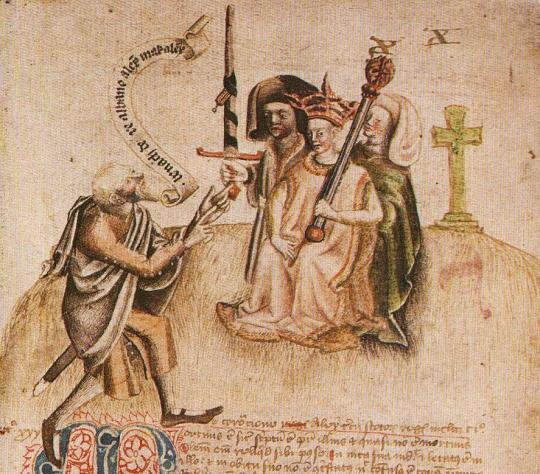
(A fifteenth century depiction of the coronation of Alexander III. Source: Wikimedia Commons)
Walter Comyn offers a typical picture of the ambitious Scottish magnate. Ultimately loyal to the Crown, his family loyalties and personal aims nonetheless made him a divisive figure. A member of the powerful Comyn kindred, he had received the lordship of Badenoch in the Central Highlands by 1229, probably because of his family’s opposition to the MacWilliams. In early 1231, he was granted the hand of a rich heiress, Isabella of Menteith. In the end, there would be no Comyn dynasty in Menteith: Walter and Isabella had a son named Henry, mentioned in a charter c.1250, but he likely predeceased his father. Nevertheless, Walter Comyn carved out a career at the centre of Scottish politics and besides witnessing many royal charters, he acted as the king’s lieutenant in Galloway in 1235 and became embroiled in the scandalous Bisset affair of 1242.
When Alexander II died in 1249, Walter and the other Comyns sought power during the minority of the boy king Alexander III. They were opposed by the similarly ambitious Alan Durward and in time Henry III of England, the attentive father of Alexander III’s wife Margaret, was also dragged into the squabble as both sides solicited his support in order to undermine their opponents. Possession of the young king’s person offered a swift route to power, and, although nobody challenged Alexander III’s right to the throne, some took drastic measures to seize control of government. Walter Comyn and his allies managed this twice, the second time by kidnapping the young king at Kinross in 1257. They were later forced to make concessions to enemies like Durward but, with Henry III increasingly distracted by the deteriorating political situation in England, the Comyns held onto power for the rest of the minority. However Walter only enjoyed his victory for a short while: by the end of 1258, the Earl of Menteith was dead.
Walter Comyn had dominated Scottish politics for a decade, and even if, as Michael Brown suggests, his death gave the political community some breathing space, this also left Menteith without a lord. As a widow, Countess Isabella theoretically gained more personal freedom, but mediaeval realpolitik was not always consistent with legal ideals. In thirteenth century Scotland, the increased wealth of widows made them vulnerable in new ways (not least to abduction) and, although primogeniture and the indivisibility of earldoms were promoted, in reality these ideals were often subordinated to the Crown’s need to reward its supporters. Isabella of Menteith was soon to find that her position had become very precarious.

At first, things went well. Although one source claims that many noblemen sought her hand, Isabella made her own choice, marrying an English knight named John Russell. Sir John’s background is obscure but, despite assertions that he was low born, he had connections at the English court. Isabella and John obtained royal consent for their marriage c.1260, and the happy couple also took crusading vows soon afterwards.
But whatever his wife thought, in the eyes of the Scottish nobility John Russell cut a much less impressive figure than Walter Comyn. The couple had not been married long before a powerful coterie of nobles descended on Menteith like hoodie-crows. Pope Urban’s list of persecutors includes the earls of Buchan, Fife, Mar, and Strathearn, Alan Durward, Hugh of Abernethy, Reginald le Cheyne, Hugh de Berkeley, David de Graham, and many others. But the ringleader was John ‘the Red’ Comyn, the nephew of Isabella of Menteith’s deceased husband Walter, who had already succeeded to the lordship of Badenoch. Even though Menteith belonged to Isabella in her own right, Comyn coveted his late uncle’s title there. Supported by the other lords, he captured and imprisoned the countess and John Russell, and justified this bold assault by claiming that the newlyweds had conspired together to poison Earl Walter. It is unclear what proof, if any, John Comyn supplied to back up his claim, but the couple were unable to disprove it. They were forced to surrender all claims to Isabella’s dowry, as well as many of her own lands and rents. A surviving charter shows that Hugh de Abernethy was granted property around Aberfoyle about 1260, but it seems that the lion’s share of the spoils went to the Red Comyn, who secured for himself and his heirs the promise of the earldom of Menteith itself.
Isabella and her husband were only released when they promised to pass into exile until they could clear their names before seven peers of the realm. John Russell’s brother Robert was delivered to Comyn as security for their full resignation of the earldom. Having ‘incurred heavy losses and expenses’, which certainly stymied their crusading plans, they fled.

In a letter of 1264, Pope Urban IV described the couple as ‘undefended by the authority of the king, while as yet a minor’. However, though Alexander III was technically underage in 1260, he was now nineteen and could not be ignored entirely. Michael Brown suggests that Isabella and her husband may have been seized when the king was visiting England, and that John Comyn’s unsanctioned bid for the earldom of Menteith may explain why Alexander cut short his stay in November 1260 and hastily returned north, leaving his pregnant queen with her parents at Windsor. Certainly, Comyn was forced to relinquish the earldom before 17th April 1261. But instead of restoring Menteith to its exiled countess, Alexander settled the earldom on another rising star: Walter ‘Bailloch’ Stewart, whose wife Mary had a claim to Menteith.
Mary of Menteith is often described as Isabella’s younger sister, although contemporary sources never say so and some historians argue that they were cousins. Either way, Alexander’s decision to uphold her claim was probably as much influenced by her husband’s identity as her alleged birth right. Like Walter Comyn, Walter Bailloch (‘freckled’), belonged to an influential family as the brother of Alexander, Steward of Scotland. From their origins in the royal household, the Stewarts became major regional magnates, assisting royal expansion in the west. The promising son of a powerful family, Walter Bailloch was sheriff of Ayr by 1264 and likely fought in the Battle of Largs in 1263. In 1260 Alexander III had the opportunity to secure Walter’s loyalty as the royal minority drew to a close. Conversely John Comyn of Badenoch found himself out of favour and was removed as justiciar of Galloway following the Menteith incident. The king would not alienate the Comyns permanently, but for now, the stars of Walter Bailloch and Mary of Menteith were in the ascendant.

(Loch Lubnaig, in the Trossachs, another former possession of the earls of Menteith)
Isabella of Menteith and John Russell had not been idle in the meantime. Travelling to John’s home country of England, they probably appealed to Henry III. In September 1261, the English king inspected documents relating to a previous dispute over the earldom of Menteith. On that occasion, two brothers, both named Maurice, had their differences settled before the future Alexander II at Edinburgh in 1213. The elder Maurice, who held the title Earl of Menteith and was presumed illegitimate by later writers (though this is never stated), resigned the earldom, which was regranted to Maurice junior. In return the elder Maurice received some towns and lands to be held for his lifetime only, and the younger Maurice promised to provide for the marriage of his older brother’s daughters.
It is probable that Isabella was the daughter of the younger Maurice, and that she produced these charters as proof of her right to the earldom. Perhaps Mary was her younger sister, but it seems likelier that Isabella would have wanted to prove the younger Maurice’s right if Mary was a descendant of the elder brother, and therefore her cousin. However despite Henry III’s formal recognition of the settlement, he did not provide Isabella with any real assistance: for whatever reason, the English king was either unable or unwilling to press his son-in-law the King of Scots on this matter. Isabella then turned instead to the spiritual leader of western Europe- Pope Urban IV.

(A depiction of the coronation of Henry III of England, though in fact the English king was only a child when he was crowned. Source: Wikimedia Commons)
A long epistle which the pope sent to several Scottish prelates in January 1264 has survived, revealing much about the case. Thus we learn that Urban was initially moved by Isabella and her husband’s predicament, perhaps especially so since they had taken the cross. Accordingly, he had appointed his chaplain Pontius Nicholas to enquire further and discreetly arrange the couple’s restoration. Pontius was to journey to Menteith, ‘if he could safely do so, otherwise to pass personally to parts adjacent to the said kingdom, and to summon those who should be summoned’. But Pontius’ mission only hindered Isabella’s suit. According to Gesta Annalia I, the papal chaplain got no closer to Scotland than York. From there he summoned many Scottish churchmen and nobles to appear before him, and even the King of Scots himself. This merely antagonised Alexander III and his subjects. Although Alexander maintained good relations with England and the papacy throughout his reign, he had a strong sense of his own prerogative and did not appreciate being summoned to answer for his actions, especially not outwith his realm and least of all in York. Special daughter of the papacy or not, Scotland’s clergy and nobility supported their king and refused to compear. Faced with this intransigence, Pontius Nicholas placed the entire kingdom under interdict, at which point Alexander retaliated by writing directly to the chaplain’s boss, demanding Pontius’ dismissal from the case.
Urban IV swiftly backpedalled. In a conciliatory tone he claimed that Pontius was guilty of ‘exceeding the terms of our mandate’ and causing ‘grievous scandal’. To remedy the situation, and avoid endangering souls, the pope discharged his responsibility over the case to the bishops of St Andrews and Aberdeen, and the Abbot of Dunfermline. Thus the pope washed his hands of a troublesome case, the Scottish king’s nose could be put back in joint, and Isabella’s suit was transferred to men with great experience of Scottish affairs, who should have been capable of satisfactorily resolving the matter. However, there is no indication that Isabella was ever compensated for the loss of her inheritance, and when the dispute over Menteith was raised again ten years later, the countess was not even mentioned (probably she had since died). Possibly her suit was discreetly buried after it was transferred to the Scottish clerics, a solution which, however frustrating for the exiled countess, would have been convenient for the great men whose responsibility it was to ensure justice was done.

(Doune Castle- the earliest parts of this famous stronghold probably date to the days of the thirteenth century earls of Menteith, although much of the work visible today dates from the late fourteenth and early fifteenth centuries)
The Comyns could not be dismissed so easily. Never resigned to losing Menteith, John Comyn of Badenoch claimed the earldom again c.1273, on behalf of his son William Comyn of Kirkintilloch. William had since married Isabella Russell, daughter of Isabella of Menteith by her second husband.* The 1273 suit was unsuccessful but William Comyn and Isabella Russell did not lose hope, and in 1282, William asked Edward I of England to intercede for them with the king of Scots. In 1285, with William’s father John Comyn long dead, Alexander III finally offered a compromise. Walter Bailloch, whose wife Mary may have died, was to keep half the earldom and he and his heirs would bear the title earl of Menteith. William Comyn and Isabella Russell received the other half in free barony, and this eventually passed to the offspring of Isabella’s second marriage to Sir Edward Hastings. Perhaps this could be seen as a posthumous victory for Isabella Russell’s late parents, but their descendants would never regain the whole earldom (except, controversially, when the younger Isabella’s two sons were each granted half after Edward I forfeited the current earl for supporting Robert Bruce).
Conversely, Walter Bailloch’s descendants remained at the forefront of Scottish politics. He and his wife Mary accompanied Alexander III’s daughter to Norway in 1281, and Walter was later a signatory to both the Turnberry Band and the Maid of Norway’s marriage negotiations. He also acted as a commissioner for Robert Bruce (grandfather to the future king) during the Great Cause. He had at least three children by Mary of Menteith and their sons took the surname Menteith rather than Stewart. The descendants of the eldest son, Alexander, held the earldom of Menteith until at least 1425. The younger son, John, became infamous as the much-maligned ‘Fause Menteith’ who betrayed William Wallace, although he later rose high in the service of King Robert I. Walter Bailloch himself died c.1294-5, and was buried next to his wife at the Priory of Inchmahome on Lake of Menteith, which Walter Comyn had founded over fifty years previously. The effigies of Walter Bailloch and Mary of Menteith can still be seen in the chapter house of the ruined priory: the worn faces are turned towards each other and each figure stretches out an arm to embrace their spouse in a lasting symbol of marital affection.
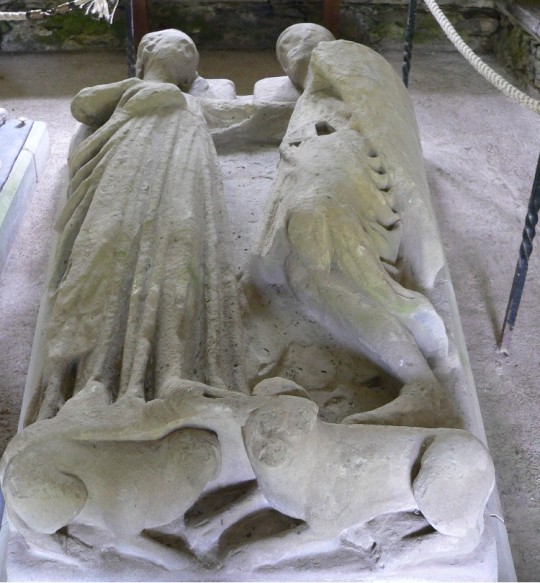
(The effigies of Walter Bailloch and Mary of Menteith at Inchmahome Priory, which was founded by Walter Comyn in 1238 and was perhaps intended as a burial site for himself and his wife Isabella of Menteith. Source: Wikimedia Commons).
The dispute over Menteith saw a prominent noblewoman publicly accused of murder and exiled, and even sparked an international incident when Scotland was placed under interdict. For all this, neither Isabella of Menteith nor John Comyn of Badenoch triumphed in the long term. Even Walter Bailloch eventually had to accept the loss of half the earldom after holding it for over twenty years. In the end the only real winner seems to have been the king. Although at first sight the persecution of Isabella and her husband looks like a classic example of overmighty magnates taking advantage of a breakdown in law and order during a royal minority, Alexander III was not a child and his rebuke of John Comyn did not result in any backlash against the Crown. Most of the Scottish nobility fell back in line once the king came of age, but the king in turn had to ensure that he was able to reward key supporters if he wanted to expand the realm he had inherited. Although it was important to both Alexander III and his father that primogeniture and were accepted by their subjects as the norm, in practice both kings found that they had to bend their own rules to ensure that the system worked to their own advantage. The thirteenth century is often seen an age of legal development and state-building, but these things sometimes came into conflict with each other, and even the most successful kings had to work within a messy system and consider the competing loyalties and customs of their subjects.
Selected Bibliography:
- “Vetera Monumenta Hibernorum et Scotorum”, Augustinus Theiner (a printed version of Urban IV’s original Latin epistle may be found here)
- “John of Fordun’s Chronicle of the Scottish Nation”, vol. 2, ed. W.F. Skene (this is an English translation of the chronicle of John of Fordun, made when Gesta Annalia I was still believed to be his work. It provides an independent thirteenth or fourteenth century Scottish account of the Menteith case
- “The Red Book of Menteith”, volumes 1+2, ed. Sir William Fraser
- “Calendar of Documents Relating to Scotland, Preserved Among the Public Records of England”, volumes 1, 2, 3 & 5, ed. Joseph Bain
- “The Political Role of Walter Comyn, earl of Menteith, during the Minority of Alexander III of Scotland”, A. Young, in the Scottish Historical Review, vol.57 no.164 part 2 (1978).
- “Scotland, England and France After the Loss of Normandy, 1204-1296″, M.A. Pollock
- “The Wars of Scotland, 1214-1371″, Michael Brown
As ever if anyone has a question about a specific detail or source, please let me know! I have a lot of notes for this post, so hopefully I should be able to help!
#Scottish history#Scotland#British history#thirteenth century#women in history#Menteith#earldom of Menteith#Isabella Countess of Menteith#John Russell#John Comyn I of Badenoch#Alexander III#Henry III#Pope Urban IV#Walter Bailloch#the Stewarts#House of Dunkeld#House of Canmore#Mary of Menteith#inchmahome priory
13 notes
·
View notes
Text
5 underrated Richard Donner movies you need to see
https://ift.tt/eA8V8J
Richard Donner will forever be remembered as the filmmaker who created the blueprint for the modern superhero blockbuster with 1978’s Superman starring Christopher Reeve.
Yet that doesn’t tell even half the story of the Bronx-born filmmaker’s brilliant filmography.
Donner was in his late 40s by the time Superman came along, having made a name for himself in Hollywood two years earlier, with 1976’s suitably terrifying The Omen.
Prior to that, he was a budding director making the transition from the small screen to the world of cinema. Donner worked on everything from Gilligan’s Island to The Twilight Zone. Even then, it was clear he was destined for bigger things though, as anyone who saw “Nightmare at 20,000 Feet”, the iconic episode of The Twilight Zone he directed, starring William Shatner, can attest.
While a disagreement with producers ultimately saw him walk away from Superman II, the 1980s saw Donner establish himself as an incredibly versatile big budget director capable of handling everything from the epic family adventure fun of The Goonies to the balancing act of action and comedy found within the buddy cop antics of Lethal Weapon.
It was a skillset that drew admiration from the very best in the movie industry, including Steven Spielberg who was among the first to pay tribute to Donner after learning he had passed away, aged 91.
“Dick had such a powerful command of his movies, and was so gifted across so many genres,” Spielberg, who worked with Donner on The Goonies, said.
“Being in his circle was akin to hanging out with your favourite coach, smartest professor, fiercest motivator, most endearing friend, staunchest ally, and – of course – the greatest Goonie of all.”
Donner may not have had the same impact in the 1990s and early 2000s but he still enjoyed major success with the Lethal Weapon franchise and as a producer with movies like Free Willy and X-Men.
More importantly, the other films he made during that period and in the years between some of his biggest hits remain well worth revisiting or seeking out for the first time – starting with these five.
Ladyhawke
Coming hot on the heels of The Goonies and two years prior to Lethal Weapon, Ladyhawke represented another major departure for Donner. A dark medieval fantasy, it centred on Rutger Hauer’s mysterious Captain Etienne Navarre and his female companion Lady Isabeau (Michelle Pfeiffer), a pair of star-crossed lovers on the run from a vengeful bishop who has placed a demonic curse on their heads. While Navarre transforms into a wolf by night, Isabeau exists as a Hawk by day. Teaming up with petty thief Philippe Gaston (Matthew Broderick) they embark on a quest to overthrow the evil bishop and break the spell.
Something of a passion project, Donner had attempted to get Ladyhawke off the ground several times before finally getting the green light from Warner Bros and 20th Century Fox in the mid ’80s. The film then suffered another setback when Kurt Russell, originally cast as Navarre, dropped out during rehearsals.
That ultimately proved a blessing in disguise with Hauer going on to deliver arguably his best performance since Blade Runner. Not everything about Ladyhawke works – Broderick’s character feels a little too close to Ferris Bueller while the runtime could be trimmed down – but it remains a beautifully realised fantasy epic, full of memorable action set pieces, stunning cinematography and a spellbinding turn from Pfeiffer.
A box office bomb upon release, Ladyhawke has stood the test of time too, garnering a cult following as an authentic and fresh take on the sword and sorcery formula.
Maverick
Maverick is the film Will Smith must have hoped Wild Wild West would be; a funny, clever action comedy based on a classic TV show. Coming in an era when most westerns were deadly serious, Donner’s film also felt like a breath of fresh air and benefited hugely from a masterful William Goldman script that was both witty and unpredictable.
The latest in a series of films featuring Donner’s muse-of-sorts, Mel Gibson, this time out Mel plays Bret Maverick, a brilliant card player and equally impressive con artist trying to collect enough money to earn a seat at a high-stakes poker game. Along the way he is forced to contend with a fellow scammer in the form of Jodie Foster’s Annabelle Bransford as well as lawman Marshal Zane Cooper, played by James Garner, who starred in the original TV series.
While the glut of cameos from country music stars and the likes of Danny Glover can be a little distracting, there’s something wonderfully charming about Maverick with Gibson, Foster and Garner all on top form and boasting an undeniable chemistry that helps keep things entertaining.
The climactic poker game which sees Maverick face off against Alfred Molina’s psychopathic Angel is also expertly handled by Donner, who cranks up the tension as Maverick reveals his final, decisive, hand with a slow-motion toss of the final card towards the camera. A critical and financial success, Maverick has been largely lost in the shuffle since its release but should be sought out.
Conspiracy Theory
There’s something strangely prescient about Conspiracy Theory given the current predilection for such thinking on the internet at large. One of Donner’s most inventive and intelligent outings alongside Gibson, this time out Mel plays Jerry Fletcher, a New York City cab driver with a penchant for paranoid conspiracy theories.
Jerry’s life takes a turn for the strange when he finds himself being targeted by a set of shady government goons led by Patrick Stewart’s Dr Jonas. He quickly realises one of the conspiracies he has been promoting in his weekly newsletter (this was the ‘90s) is based more in reality than he thought. The question is: which one?
An engrossing thriller featuring Donner’s trademark dashes of witty humour, Conspiracy Theory is bolstered significantly by the presence of the ever-reliable Julia Roberts as a government lawyer with a soft spot for Jerry. Despite a lengthy run time, Donner also keeps the action moving along at an engaging pace while Gibson’s performance is just the right side of manic to keep you rooting for him.
A first foray into the kind of deep state conspiracy thrillers that were commonplace in Hollywood at the time, the film also boasts some genuinely striking moments, not least the sequence where Jerry undergoes “psychotic testing” at the hands of Dr Jonas, which wouldn’t have looked out of place in A Clockwork Orange.
Though it was a hit with audiences, Conspiracy Theory earned mixed reviews but appears increasingly worthy of reappraisal.
Timeline
Some movies are big, dumb but lots of fun. Timeline sits firmly in that category despite what many naysayers would have you believe. It’s a brash, simplistic sci-fi flick to rival the likes of The Core and Geostorm and thoroughly entertaining to boot.
The fact that it features Gerard Butler, as well as the late, great, Paul Walker only adds to that sentiment.
Walker plays Chris Johnston who, along with Butler’s Andre Marek and a team of fellow archaeologists travel back in time through a wormhole to 14th century France to rescue their professor, Dr Edward Johnston (Billy Connolly), who just happens to be Walker’s character’s dad too.
Based on a book by Michael Crichton, Donner had been in the running to direct Jurassic Park a decade earlier and jumped at the chance to adapt Timeline for the big screen. While filming went off without a hitch, Donner repeatedly clashed with Paramount Pictures in post-production and was forced to re-cut the film three times in a development that saw the release date pushed by nearly a year. The resulting edit did not sit well with Crichton either, who disliked it so intensely he stopped licensing his work for a few years after.
Whether Donner’s original cut would have earned better reviews or Crichton’s approval remains to be seen but what remains of Timeline is still a well shot, enjoyable sci-fi yarn with some neat medieval action flourishes.
16 Blocks
Donner’s final film also ranks among his most unappreciated. On the surface, 16 Blocks sounds like the perfect fodder for a game of buddy cop movie bingo.
It stars Bruce Willis as Jack Mosley, a worn-out NYPD Detective with a drinking problem tasked with transporting Mos Def’s trial witness Eddie Bunker to court. Problems arise when some of Jack’s fellow officers arrive to kill Eddie and prevent him from testifying. Eager for redemption, Jack decides to take the would-be assassins on and get Eddie to court on time.
A formulaic enough premise, 16 Blocks is emboldened by the fact it plays out in real-time with Eddie required at the courthouse by no later than 10am. In this sense, Donner found himself in new territory with an action thriller that thrives on a unique sense of urgency.
While the filmmaker is no stranger to the action formula, this setup sees him imbue events with a renewed sense of chaos, as Jack and Eddie fight their way through armed adversaries, busy crowds and bustling traffic, all against a cacophony of shouts, car horns and gun blasts.
Ostensibly a chase movie on foot rather than four wheels, the action traverses 16 blocks in 118 minutes and rarely lets up for a second with Donner proving a dab hand at balancing the action with the engaging back-and-forth between Willis and Def who are both understated yet effective throughout.
cnx.cmd.push(function() { cnx({ playerId: "106e33c0-3911-473c-b599-b1426db57530", }).render("0270c398a82f44f49c23c16122516796"); });
Throw in the ever-watchable David Morse as the leader of the shady cops baying for Eddie’s blood and you have arguably one of the most underrated action thrillers of the early 2000s
The post 5 underrated Richard Donner movies you need to see appeared first on Den of Geek.
from Den of Geek https://ift.tt/3AA61tK
2 notes
·
View notes
Text
Research Essay
Research
· Born 5 January 1941) is a Japanese animator, director, producer, screenwriter, author, and manga artist. A co-founder of Studio Ghibli, a film and animation studio, he has attained international acclaim as a masterful storyteller and as a maker of animated feature films, and is widely regarded as one of the most accomplished filmmakers in the history of animation.
· Miyazaki co-founded Studio Ghibli in 1985
· Hayao Miyazaki was born on 5 January 1941, in the town of Akebono-cho in Bunkyō, Tokyo, the second of four sons.[1][c] His father, Katsuji Miyazaki (c. 1915 – 18 March 1993),[3] was the director of Miyazaki Airplane, which manufactured rudders for fighter planes during World War II.[4] The business allowed his family to remain affluent during Miyazaki's early life.[5][d] In 1944, when Miyazaki was three years old, his family evacuated to Utsunomiya.[4] After the bombing of Utsunomiya in July 1945, Miyazaki's family evacuated to Kanuma.[5] The bombing left a lasting impression on Miyazaki, who was aged four at the time.[5] From 1947 to 1955, Miyazaki's mother suffered from spinal tuberculosis; she spent the first few years in hospital, before being nursed from home.[4] Miyazaki's mother was a strict, intellectual woman, who regularly questioned "socially accepted norms"
· He aspired to become a manga artist,[11] but discovered he could not draw people; instead, he only drew planes, tanks, and battleships for several years.[11] Miyazaki was influenced by several manga artists, such as Tetsuji Fukushima, Soji Yamakawa and Osamu Tezuka. Miyazaki destroyed much of his early work, believing it was "bad form" to copy Tezuka's style as it was hindering his own development as an artist
· Miyazaki's works are characterized by the recurrence of themes such as humanity's relationship with nature and technology, the wholesomeness of natural and traditional patterns of living, the importance of art and craftsmanship, and the difficulty of maintaining a pacifist ethic in a violent world. The protagonists of his films are often strong girls or young women, and several of his films present morally ambiguous antagonists with redeeming qualities
· Miyazaki's film Princess Mononoke was the first animated film ever to win the Japan Academy Prize for Picture of the Year, and briefly became the highest-grossing film in Japan following its release in 1997;[a] its distribution to the��Western world greatly increased Ghibli's popularity and influence outside Japan. His 2001 film Spirited Away became the highest-grossing film in Japanese history,[b] winning the Academy Award for Best Animated Feature at the 75th Academy Awards, and is frequently ranked among the greatest films of the 2000s
· Born in Bunkyō ward of Tokyo, Miyazaki expressed interest in manga and animation from an early age, and he joined Toei Animation in 1963. During his early years at Toei Animation he worked as an in-between artist and later collaborated with director Isao Takahata.
· In September 2013, Miyazaki announced that he was retiring from the production of feature films due to his age, but wished to continue working on the displays at the Studio Ghibli Museum
· In August 2016, Miyazaki proposed a new feature-length film, How Do You Live?, on which he began animation work without receiving official approval.[155] In December 2020, Suzuki stated that the film's animation was "half finished" and added that he does not expect the film to release for another three years
Possible Hayao Legacy’s:
· Traditional Art/Animation (compare to Walt Disney – timeline)
· Timeless messages despite set eras/worlds etc…
· His artistic style
· Expressionism and Surrealism doesn’t seem to stray too far from reality
· Harmony of art and music
· Tells his own stories through his work (like a grandfather to all his viewers exaggerating his life stories to the viewers)
Walt Disney Overview:
· Walter Elias Disney (/ˈdɪzni/;[1] December 5, 1901 – December 15, 1966) was an American entrepreneur, animator, writer, voice actor and film producer. A pioneer of the American animation industry, he introduced several developments in the production of cartoons. As a film producer, Disney holds the record for most Academy Awards earned by an individual, having won 22 Oscars from 59 nominations. He was presented with two Golden Globe Special Achievement Awards and an Emmy Award, among other honors. Several of his films are included in the National Film Registry by the Library of Congress.
· Born in Chicago in 1901, Disney developed an early interest in drawing. He took art classes as a boy and got a job as a commercial illustrator at the age of 18. He moved to California in the early 1920s and set up the Disney Brothers Studio with his brother Roy. With Ub Iwerks, Walt developed the character Mickey Mouse in 1928, his first highly popular success; he also provided the voice for his creation in the early years. As the studio grew, Disney became more adventurous, introducing synchronized sound, full-color three-strip Technicolor, feature-length cartoons and technical developments in cameras.
· Disney was a shy, self-deprecating and insecure man in private but adopted a warm and outgoing public persona. He had high standards and high expectations of those with whom he worked. Although there have been accusations that he was racist or anti-Semitic, they have been contradicted by many who knew him. His reputation changed in the years after his death, from a purveyor of homely patriotic values to a representative of American imperialism. He nevertheless remains an important figure in the history of animation and in the cultural history of the United States, where he is considered a national cultural icon. His film work continues to be shown and adapted; his namesake studio and company maintains high standards in its production of popular entertainment, and the Disney amusement parks have grown in size and number to attract visitors in several countries.
Miyazaki’s Legacy in comparison to Walt Disney
· Miyazaki’s Legacy has the potential to keep developing as he has come out of retirement, whereas Walt Disney cannot because he is dead.
· Disney’s iconic 2D style started to decline in 2005 after the release of Chicken Little, but officially came to an end in 2013 with their 3D movies rising rapidly to success.
· Ghibli released its first 3D animated movie Earwig and the Witch in 2020 without Miyazaki’s involvement and ended up not being as successful. However Miyazaki himself is out of retirement and working on his own 2D movie for which is far more anticipated. Proves his legacy is still strong because the Ghibli name is so heavily tied to his style despite it not conforming to the 3D take over.
· Although exaggerated, Ghibli seems to capture emotion more realistically imperfect that Disney.
· A majority of Disney films are based on stories that are already out there, prequels, sequels, remasters etc… whilst although Ghibli takes some inspiration from pre-existing stories… is mostly original.
· From the beginning till now Miyazaki represented strong, independent women. Disney on the other hand took a lot longer. Could be argued that Disney was around a lot sooner in History when people were less open minded.
· Ghibli is a lot less censored than Disney, making t both more and less accessible to certain viewers. Even though a majority of Ghibli isn’t too graphic, there are some mature themes that put an age limit on 1 or 2 of the films. Could be seen as what makes Ghibli more realistic and emotionally
· Though Ghibli has a lack of diversity in its characters, they are otherworldly enough, as well as relatable enough for all audiences to fall in love with. Disney has shown a lot more progression with it’s diversity and representation, however that can’t make up for the offensive undertones he began his legacy with. Neither are perfect but at least Miyazaki never insulted anyone from a different culture.
· Practically all of Miyazaki’s main characters are human without power or fancy clothing, putting emphasis on the impact everyone and anyone can make on the world. Disney tends use a lot less realistic characters, even humanising those that are not, perhaps to avoid encouraging certain behaviour to children?
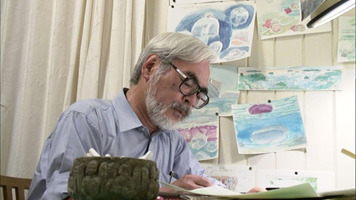
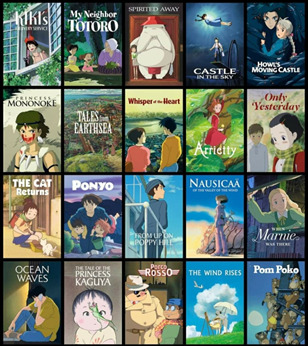
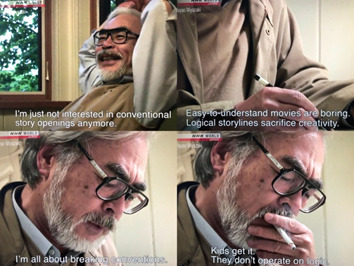







6 notes
·
View notes
Text
A Journey to France to Uncover the Mysteries of the Carnegie’s Grand Staircase
The Carnegie Institute has been in existence for 125 years and is one of the greatest architectural buildings ever designed in Pittsburgh. In 1985, Carnegie Institute President Robert Wilburn invited Dr. Cynthia R. Field, the Smithsonian’s Architecture Historian, to assess the artistic value of the museum. He asked, “what do you think is the most valuable specimen or painting in the museum?” She said, “The Building Itself is the Greatest Object of the entire Museum Collection” (Fig. 1).
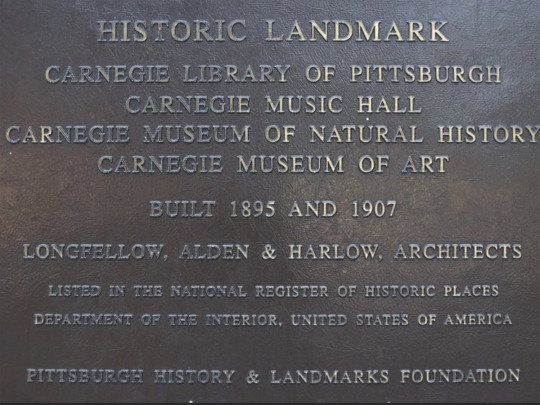
Fig. 1: Carnegie plaque
The internationally-famous architect, I.M. Pei, who designed the Louvre’s glass pyramid that sits in the Louvre’s central courtyard in Paris, France, opined, “Architecture is the very mirror of life. You only have to cast your eyes on buildings to feel the presence of the past, the spirit of a place; they are the reflection of society.” In 2018, Architecture Digest ranked the Carnegie’s Grand Staircase the 8th best museum staircase in the world. The Grand Staircase was built by the Pittsburgh architectural firm of Alden and Harlow at the apex of America’s Gilded-Age building boom. During my research, I discovered that the architects employed multicolored classic marbles and fossil limestones in the interior design from Algeria, Croatia, Greece, France, Ireland, Italy, and the United States. The commission to build the Grand Staircase in 1907 incorporated two classical French fossil limestones in the columns and pillars, floor tiles, steps, walls, balconies, and water fountains. This monumental Beaux-Arts style staircase is modeled after the L‘Opéra Garnier ‛a Paris, Grand Staircase in France, c. 1875, and was visited by a French Delegation with Andrew Carnegie (Fig. 2). The architecture described as Beaux-Arts was taught at the École des Beaux-Arts in Paris, from the mid-19th century until 1900. It drew upon the principles of French neoclassicism and used modern building materials, i.e., iron and glass. And as such, it became a preferred architectural style in the United States from 1895 until 1910 in cities such as, Boston, Chicago, New York City, Pittsburgh, and Washington D.C.

Fig. 2: French delegation and Andrew Carnegie
In 2019, The Carnegie’s Grand Staircase and Music Hall Foyer were recognized in the book La pierre de l’Échaillon Une histoire locale, une renommée international for the use of Échaillon jaune (yellow) ornamental stone in the museum’s columns, pillars, and walls (Fig. 3). This book was published by S.P.I.A. (Sauvegarde du Partrimoine Industriel d’Autrefois, a historical society founded by Jean Paul Rey, president) (Fig. 4). In the book, they describe how a small French village of l’Échaillon, pronounced Esh-ee-own, received recognition for its white marble (a limestone) used by famous French architects in 64 classic buildings and sculptures from 1875 to the early 20th century (Fig. 5). I first met Jean Paul in October of 2016, when I was invited to give a presentation at an S.P.I.A. meeting on my research on the Carnegie’s l’Échaillon. The meeting was held in an old schoolhouse in the village of Saint-Quentin-sur-Isère, Département de Isère, in southeast France.
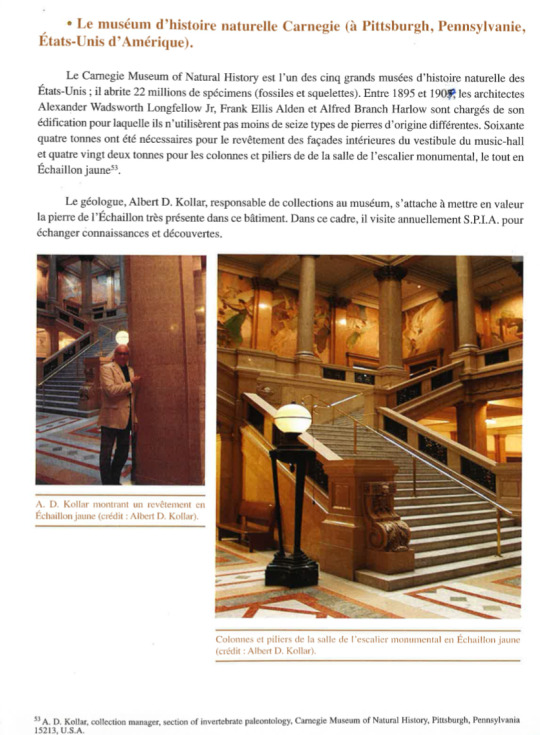
Fig. 3: The Grand Staircase

Fig. 4: Jean Paul Rey and Albert D. Kollar
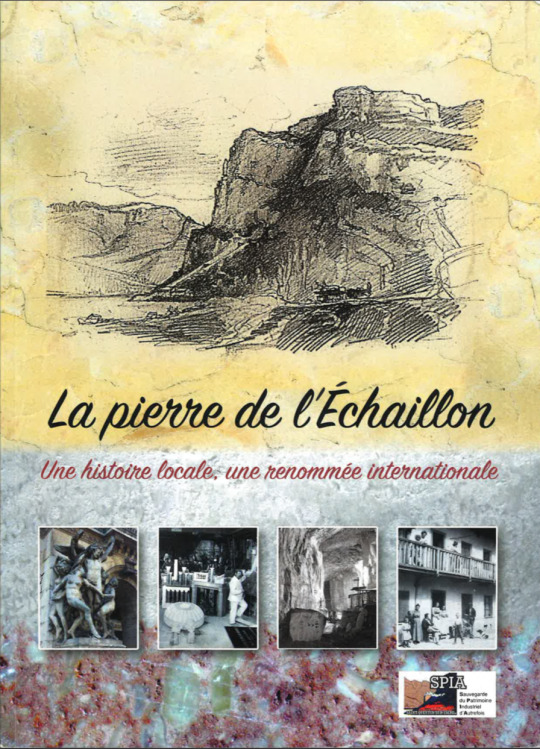
Fig. 5: Book cover
The French Limestones in the Carnegie’s Architecture
The Carnegie building stones research project progressed significantly, once we obtained the digital images of the architect’s blueprints from the Carnegie Museum of Art’s Architecture Department. With the assistance of my co-authors, Rich Fedosick and Kay Hughes of the Section of Invertebrate Paleontology, we examined the blueprints to understand the architects Marble Index terminology (Fig. 6). Eventually, we were able to interpret and recognize the location of the two French limestones based on the Marble Index letters, E for Échaillon and H for Hauteville. From a nonscientific perspective, the architects considered the Carnegie’s interior stones to be marbles. However, the geological definition of a marble is when a rock defined as a limestone or dolomite is subjected to high heat and pressure from geologic forces forms a metamorphic rock. The six stones listed in the Marble Index as marbles, are limestones, a sedimentary rock enriched with fossil seashells. The characteristic rudist fossils and yellow color that distinguish the Échaillon stone are found in the 18 pillars and the 22 columns that rise 3.8 meters or 12.5 feet about the Grand Staircase, and in the walls of the Music Hall Foyer (Fig. 7).
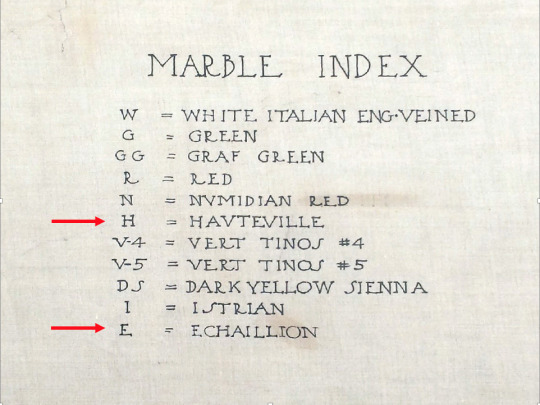
Fig. 6: Marble index E and H letters

Fig. 7: Échaillon fossils
The other French limestone used in the Carnegie is Hauteville. This limestone was quarried from the Plateau d’Hauteville in the Ain Department, in eastern France. I visited this quarry in 2016 to investigate the geology of the quarry operation, to uncover evidence of the common fossil snail Nerinea in the quarry rock (Fig. 8), and to learn more about the cultural history of the region (Fig. 9). The Hauteville limestone was used in the Grand Staircase walls, balcony features, water fountains, vestibule steps, and as floor tiles. Other locations include, the Hall of Sculpture and Hall of Architecture floors, the walls along the grand hallway, the Music Hall vestibule floor, the Founder’s Room vestibule floor, the floor and steps in the Smoking Room (now offices), the Forbes Avenue vestibule entrances to the music hall, carriage drive, and museum and fine arts. Moreover, the Hauteville floor tiles are distributed throughout the Carnegie Library of Pittsburgh main entrance corridors. The Hauteville stone is beige in color and contains many visible fossils, none more distinctive than the robust Nerinea, a 12.7 cm/5-inch-long snail that serves as the index fossil for the limestone identification (Fig. 10).

Fig. 8: Hauteville Quarry fossil snail

Fig. 9: Hauteville directional signs

Fig. 10: Nerinea snail in Carnegie floor
Introduction to the l’Échaillon Carrières
There are three carrières or quarries in the Vercors cliffs located in the Isère River Valley that were excavated for White Echaillon or “Echaillon blanc,” Yellow Echaillon or “Echaillon jaune,” and Pink Echaillon or “Echaillon rose” during the 19th and early 20th century (Fig. 11). These unique color combinations became popular for various interior and exterior architecture features in 194 buildings in western Europe, North Africa, and the United States. In 2016, Jean Paul Rey and members of S.P.I.A. led me on a field trip to the abandoned classic l’Échaillon white quarries (Fig. 12). We explored what is thought to be a 2,000-year-old Roman quarry and walked through a maze of underground caverns and narrow tunnels that contained abandoned mining equipment. The other two Echaillon carrières are located several kilometers south in the small villages of Lignet, where the Pink Echaillon was quarried (Fig. 13) and Rovon, where the Yellow Echaillon was excavated (Fig. 14).

Fig. 11: Echaillon quarries locations, S.P.I.A.
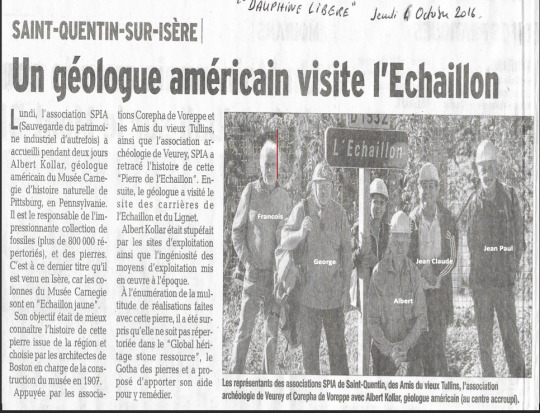
Fig. 12: Visit to Echaillon

Fig. 13: Lignet Quarry Marker

Fig. 14: Rovon quarry
Cularo, Grenoble, and the white l’Echaillon stone
A fortuitous discovery was made by S.P.I.A. for their book while searching for evidence of the white l’Echaillon in the Gallo-Romans era 4th century Cularo or Grenoble, France today. In the Saint Laurent crypt that is preserved many meters below the modern-day street level tramway, a white capitol on top of a white limestone column was identified as l’Echaillon. This white capitol stone is presumably from the Roman quarry adjacent to the white l’Echaillon underground caverns. When Emperor Gratian ruled the Roman Empire from 367 to 383 A.D., he renamed Cularo after himself. Cularo thus became Gratianopolis, which through a later phonetic shift became Graignovol and then Grenoble. Although hard to find among the narrow streets and passageways of Grenoble, is a section of a Roman wall that once encircled Cularo, a portion of which is protected by a fence. This historic wall can be seen at Passage Sainte-Claire on the corner of Rue Lafayette, in the central city of Grenoble (Fig. 15). I suspect some of the white cobbles embedded in the wall may have their origin from the white l’Echaillon Roman quarry. Undoubtedly, more research will be necessary to make an affirmative conclusion.

Fig. 15: Roman wall
“Geology of the l’Échaillon Carrières”
The drawing of a new geologic map on the l’Echaillon carrières by Professor Thierry Dumont of the Université Grenoble-Alpes, confirms stratigraphically, the ages of the three limestone quarries. Among the three, the white Echaillon limestone is late Jurassic in age, whereas the pink Lignet and yellow Rovon limestones are early Cretaceous in age. The formal geologic name for the rose and yellow limestones is the Urgonian Formation. Fossils are abundant in the three limestones. Dr. Claudie Durand of Le musèum d’Histoire naturelle de Grenoble (Fig. 16) curated a diverse collection of 163 species of invertebrate fossils from l’Echaillon first published in 1919. Geologically, the three limestones were deposited in the tropical Tethys Seaway a circum-equatorial ocean of the Mesozoic Era. The strata form the Vercors carbonate platform, a buildup of late Mesozoic rudist (bivalve mollusk) reefs spanning 25 million years of evolution from (late Jurassic 140 million years ago to early Cretaceous 165 million years ago) (Fig. 17).

Fig. 16: Dr. Claudie Durand

Fig. 17: Rudist (bivalve) reef fossils
The Rovon carrière provenance and fossils
The primary goal of this research is to define the geology and authenticate the specific provenance of all marbles, fossil limestones, sandstones, and the singular igneous granite rock used in the Carnegie building. The search for the provenance of the Carnegie’s yellow Echaillon was initiated in December of 2017 by Jean Paul Rey, when we were introduced to the Forman of the modern-day Rovon quarry. After a long discussion about our objectives, he granted permission to visit the old quarry. As darkness fell, we met with a local farmer who directed us to the quarry location in the Vercors cliffs that rise some 538 meters above his snow-covered field (Fig. 18).

Fig. 18: Verors cliffs and old Rovon quarry
In October of 2018, the S.P.I.A. team pre-arranged to have several 4-wheel trucks transport ten people including Professor Fabienne Giraud-Guillot of the Université Grenoble-Alpes to the Rovon quarry. We ascended the long steep road that ended some 500 m from the main quarry. Surprisingly, the quarry was filled with massive limestone boulders that were cut by mechanical wire saws from the cliff rock (Fig. 19). Such large boulders make it virtually impossible to break with small hammers. For actual fossil collecting purposes, it is better to search for smaller size rocks to break apart (Fig. 20). This past October, transport to the Rovon quarry riding in a 55-year-old Russian built farm tractor was a treat (Fig. 21). And the fossil collecting was a success with 21 complete specimens collected for the museum of the diagnostic Caprina rudist bivalve clam (Fig. 22). The shape of these fossils closely resembles the fossils preserved in the Echaillon limestone in the Grand Staircase and Music Hall Foyer. Additional geologic data is being reviewed by colleagues from the Geology Department at the University of Zagreb in Croatia and the University of Ireland at Galway.

Fig. 19: S.P.I.A. team

Fig. 20: Collecting fossils

Fig. 21: Russian tractor

Fig. 22: Caprina rudist clam
“Carnegie’s Grand Staircase in the 21st Century”
A study published this month by the BMJ, formerly The British Medical Journal, suggested that “when people of all ages participate in the arts and visit museums once a month or even every few months, they are likely to be more engaged in the world and may actually live longer.” Years ago, the Oscar winner actor Russell Crowe was in Pittsburgh, and he was asked what he did on his days off. In reply, he said, “I ride my bicycle to look at buildings and the architecture of the city.” I. M. Pei states, “Architecture brings people together.” I agree.
Maybe it’s time to reconsider how the Carnegie’s Grand Staircase is promoted to the public at large. For instance, the current arrangement of the free-standing dioramas situated on the first floor, awkwardly impede the flow of patrons walking among the pillars, columns, and the taking of photographs of the Grand Staircase. Moreover, the placement of these dioramas detracts from the visual enjoyment of the famous John White Alexander multicolor murals. An artistic feature of the murals is their connection to the stone colors to enhance the first and second floors architectural features. The best vantage points to see this fabulous spectrum of color is from the third-floor balcony looking down to the first and second floors.
The Carnegie Museum of Art (Museum of Fine Arts) will be celebrating its 125th Anniversary in the fall of 2020. The Grand Staircase was designed as the showcase entrance to the Museum of Fine Arts for Pittsburghers of the early 20th Century. One hundred and twenty-five years later, perhaps, this world-class space can once again establish a new generation of museum patrons and become the destination as a place to be for its cultural and intellectual heritage. And don’t forget, this staircase can be an Instagram-worthy site for a family portrait to encourage our younger audiences to visit too.
Albert D. Kollar is the Collection Manager in the Section of Invertebrate Paleontology at Carnegie Museum of Natural History. Museum employees are encouraged to blog about their unique experiences and knowledge gained from working at the museum.
88 notes
·
View notes
Text
Pocket Guide to the Empire, First Edition: Cyrodiil
Cyrodilic history truly begins by the middle of the Alessian Reformation (see sidebar, Alessian Order), when civilisation and cultivation had allowed the region to emerge as a discernible Tamrielic power. Its culture and military strength centred in the sacred Nibenay Valley, a grassland expanse with a vast lake at its heart. Several small islands rose from this lake, and the capital city sprawled across them, crisscrossed with bridges and gondola ferries. Rivers connected the city-state to both its profitable outlying territories and the friendly inland ports of Skyrim and Pelletine. Rice and textiles were its main exports, along with more esoteric treasure-goods, such as hide armour, Moon sugar, and ancestor-silk. The sheer size of Cyrodiil's physical theatre, and frequent intervals of Elven tyranny, made its unification as a while a slow and oft-interrupted process. At the height of Alessian influence, its western arm enjoyed a brief autonomy as the Colovian Estates, a demarcation that still colours an outsider's view of the Empire today; often, Cyrodiil has two faces, East and West, and any discussion of its later social history must first be tempered with a summary of this early divergence.
Traditionally, the East is regarded as the region's soul: magnanimous, tolerant, and administrative. It was in the rain forests of the Nibenay Valley that the original Cyro-Nordic tribes, the Nibenese, learned a self-reliance that separated them culturally and economically from Skyrim. The Elven harassment of the First Empire gave rise to an elite form of support troop for the Valley armies, the battlemage.[1] By the time the Alessian Doctrines filtered down from the north along the river trade ways, these mages had become the ruling aristocracy. They were quickly superseded by the Alessian priesthood, whose inexplicably charismatic religion found purchase in the lower classes. The traditional Nordic pantheon of Eight Divines was replaced by a baroque of veneration of ancestor spirits and god-animals, practices encouraged by the mutable-yet-monotheistic doctrines of the Alessian faith. The doctrines eventually codified nearly every aspect of Eastern culture. Restrictions against certain kings of meat-eating, coupled with the sentiments of the blossoming animal cults, soon made agriculture and husbandry nearly impossible. Thus, many of the Eastern Cyrodiils were forced to become merchants, which, over time, allowed the Nibenay Valley to become the wealthiest city-state in the region. Yet, under Alessian rule, no matter how rich or powerful the merchant class became it was still a tenanted citizenry, and the tithes they were forced to pay the priesthood were constant reminders of the state's true masters.
The West is respected as Cyrodiil's iron hand: firm, unwavering, and ever-vigilant. The Cyro-Nords that settled it had relinquished the fertile Nibenay Valley long ago, determined to conquer the frontier. Their primitive ferocity was disinclined to magic or the need for industry, preferring bloody engagement and plunder instead. After they had captured the Nedic port-cities of the Strident coast, the Westerners embarked on a mastery of the sea. Their earliest voyages took them as far as the Iliac Bay and the Cape of the Blue Divide, whose ports they annually raided until the (then) superior Yokudan navies arrived, ca. 1E819. By the time of the Alessian Reformation, the Westerners were firmly in a position, both geographically and socially, to resist its doctrines. Hammerfell, its northern border state, was now protected by its own holy-avenging order, the Ra Gada, whose bloody intolerance for foreigners acted as West Cyrodiil's buffer against the Alessian priesthood. The pantheon of Eight Divines, therefore, survived unchecked in Western Cyrodiil, and relations with the increasingly Alessian East became strained. Ultimately, the West isolated itself from the theocratic hegemony of the Nibenay Valley, establishing an autonomous government, the Colovian Estates.
Things persisted in this vein until the Thrassian Plague of 1E2200 (see free Region - Thras), which decimated more than half of Tamriel's population, particularly the western coastlands closest to Thras. After Bendu Olo, the Colovian king of Anvil, led the All Flags Navy to victory over the slugfolk of Thras, the glory of the Cyrodilic people became known throughout the world. The Colovian Estates began to overshadow the richer, more populous East then, which eventually lead to the War of Righteousness that ended Alessian rule. Control of the Nibenay Valley reverted to a mercantile-magocracy that was still far too arcane for Western tastes to entertain a reunification of Cyrodiil. Four hundred years would pass before that would happen, when Reman I, another proud son of the West, rallied the Valley's army to join his own and fight the Akaviri Invasion of 1E2703. The Cyrodilic forces engaged the Akaviri in every region of the north, eliciting their surrender at last in the Pale Pass of Skyrim. By war's end, the Cyrodiils found themselves not only united as a nation, but, too, responsible for the further protection of the northern human kingdoms at large. When the Elves of the Summerset Isles took umbrage at what they perceived as a renewed human imperialism, Reman was forced to prove them right. In order to prevent the Elves from attacking[2] the already weakened northern kingdoms, he offered the captive Akaviri Horde amnesty in his future dominions if they would serve as the nucleus of the Army of the Second Empire of Men. Reman's own dynasty lasted for two hundred years, and in that span it conquered all the kingdoms of Tamriel except for Morrowind. Indeed, the Dark Elven Morag Tong were the doom of Reman's heirs, and the death of last true Cyrodilic Emperor heralded the beginning of the Common Era.
The Cyrodilic Empire endured for another four hundred years under the auspices of the Akaviri Potentate (see sidebar, The Second Empire), fell, and suffered a similar span of years in the insurrections, misrules, and loss of power known as the Interregnum. Yet, the remnants of the Cyrodilic Empire refuse to die, even though East and West had become fragmented beyond measure. A petty king of the Colovian Estates, Cuhlecain, came to power and appointed an Atmoran as General of his legions. General Talos had studied in Skyrim, and used the thu'um. He could rout armies with his battle-cry and shout lesser men off their feet. A year later more than half of the Cyrodilic Empire was reclaimed or consolidated, and Cuhlecain saw fit to move into the Nibenay Valley, capture the capital city, and proclaim himself Emperor. By this point, High Rock and Skyrim, which bitterly opposed a return to Cyrodilic rule, gathered their armies for a joint invasion of the Colovian West. Talos met them on the field of Sancre Tor. The Nords that had come to cripple the Empire soon joined the General's forces, for when they heard his thu'um they realised he was Skyrim's son and the Heir to the Empires of Men. The Bretons were sent back to High Rock with tales of Cuhlecain's new General, where they decided to combat the Emperor's sorcery with their own. In CE854, a nightblade from the Western Reach made his way to the Imperial Palace at Nibenay. There, the Witchman assassinated the emperor, caught the Palace on fire, and slit the throat of General Talos. "But from the smouldering ruin he came, one hand to his neck and with Cuhlecain's Crown in the other. The legions wept at the sight. His Northern magic had saved him, but the voice that led them would be more silent from that night on. His word could no longer rout an army with a roar, but he could still command one with a whisper. He took for himself a Cyrodilic name, Tiber Septim[3], and the Nordic Name of Kings, Ysmir, the Dragon of the North. And with those names he took, too, the Red Diamond Crown of the Cyrodiils, and became their True Emperor." Thus was born the Third Empire of Men.
Cyrodiil in the Third Empire is the young, viral embodiment of its ancient heritage. Internally, it has undergone an incredible restoration--reconstruction of the ruined sections of the Imperial City is nearly complete, roads and cities destroyed in the Interregnum have been rebuilt, East and West are unified for the first time in four centuries. Cyrodiil's present stability and strength have not been seen since the Reman Dynasty; indeed, they were born under similar circumstances--a Westerner winning the Eastern throne, forging them both into the greatest power in Tamriel. And now, in but twenty years time, Tiber Septim has secured Imperial authority in High Rock, Skyrim, and Hammerfell. Every human region stands with him against the Elven menace.[4] The Emperor has gracefully attributed his success to his peoples, the Colovians and the Nibenese, whose cultures we shall now treat in their current incarnation.
The Colovians[5] today still possess much of the frontier spirit of their ancestors. They are uncomplicated, self-sufficient, hearty, and extremely loyal to one another. Whenever the East would tremble under the weakness of a leader, the Colovians would withdraw unto themselves, always believing they were keeping the national spirit sage until the storm passed. They realise that the Nibenay Valley is the heart of the Empire and the cultural centre of its civilisation, but it is a fragile centre that can only be held together by the strength of character of its Emperor. When he falters, so do the Colovians. Yet when he is mighty, like Tiber Septim, they are his legions. Today, West Cyrodiils make up the majority of the soldiers in the Ruby Ranks. The Colovian nobility, all officers of the Imperial Legions or its West Navy, do not allow themselves the great expenditure of courtly life as is seen in the capital city. They prefer immaculate uniforms and stark standards hanging from the ceiling of their austere cliff-fortresses; to this day, they become a little perplexed[6] when they must visit the grandly decorated assault of colour that is the Emperor's Palace.
[TRAVELER: "Colovian officers have traditionally been appointed as provincial governors to the human regions of the Empire, as these often need the most forthright of the Emperor's men."]
By contrast, the Eastern people of Cyrodiil relish in garish costumes, bizarre tapestries, tattoos, brandings, and elaborate ceremony. Closer to the wellspring of civilisation, they are more given to philosophy and the evolution of ancient traditions. The Nibenese find the numinous in everything around them, and their different cults are too numerous to mention (the most famous are the Cult of the Ancestor-Moth, the Cult of Heroes, the Cult of Tiber Septim, and the Cult of Emperor Zero). To the Colovians, the ancestor worship and esoteric customs of the East can often be bizarre. Akaviri dragon-motifs are found in all quarters, from the high minaret bridges of the Imperial City to the paper hako skiffs that villagers use to wing their dead down the rivers. Thousands of workers ply the rice fields after the floodings, or clear the foliage of the surrounding jungle in the alternate seasons. Above them are the merchant-nobility, the temple priests and cult leaders, and the age-old aristocracy of the battlemages. The Emperor watches over them all from the towers of the Imperial City, as dragons circle overhead.
Alessian Order
This monotheistic religion was once very popular, but today only remnants of its faith remain. It started in the coastal jungle of what is now the Colovian west, where a prophet named Marukh, who had spoken to the "Enlightened One," Saint Alessia, began to question the validity of Elven rule. These sentiments led to an increasingly abstract and unknowable depiction of a Single God. The Alessians were wise enough to realise that they had to incorporate the ancient polytheistic elements into their new religion for it to find a wide acceptance. The divine aspects worshipped by the various humans and Aldmeri were recognisable in the guise of the myriad saints and spirits of the evolving Alessian canon. It wasn't long before the Order was the Authority on every religion in Tamriel, and their power grew to earthshaking proportions. Nearly a third of the First Era passed under their theocratic rule. When its priesthood had become too widespread to support itself, the Order began to fight among itself. With the severance of the territories of West Cyrodiil from the Empire, too much money and land had been lost. The War of Righteousness broke out, and the Order which had almost ruled the world undid itself in a ten year span.
The Second Empire
The Second Empire is divided into two stages: the Reman Dynasty and the Akaviri Potentate. As mentioned in the text, after the Akaviri raiders had been defeated, Reman recruited many of them into his service. Later Cyrodiils traditionally kept a House Guard of Akaviri, and the Emperor's chief advisor, the Potentate, was usually of Akaviri descent. Other Akaviri slaves played a significant part in establishing the administrative structures of the Second Empire, as well as in the training of its military. The restructured Imperial legions, which learned an unparalleled measure of coherence, logistics, and discipline from the Akaviri, began to easily overwhelm the other regional armies; soon every region in Tamriel belonged to Cyrodiil except for Morrowind. After the assassination of Reman's last heir by the Dark Elven Morag Tong during the disastrous Four Score War, control of the Empire reverted to the Akaviri Potentate. They have left a visible mark on the Empire of today. The high crafts of daikatanas and dragonscale armour came from the Akavir, as did the banners and military dress of Septim's shock troops, the Blades. The Red Dragons that have come to represent the Empire and the Imperial City were originally Akaviri war mounts. Akaviri surnames are rare and prized possessions among the Cyrodilic citizenry of today, and there are trace facial features of the Akaviri in many distinguished Cyrodilic families. Some colonies of "true Akaviri" still exist in both the Empire and its border regions, but they are named so only for their practices and customs than for the purity of their blood.
The Song of Tiber Septim[7]
From the Odes:
"He was born in Atmora as Talos, 'Stormcrown' in the language of the ancient Elhnofey, and it was from that shore he sailed. He spent his youth in Skyrim among the Nords. There he learned much from the Tongues and their chieftains and their ways of war. At twenty he led the invasion of Old Hrol'dan, taking it back from the Witchmen of High Rock and their kinsmen.
"Soon the Greybeards made known that they were restless. Already the storms had begun from their murmurs. The Greybeards were going to Speak. The surrounding villages were abandoned as the people fled the coming blast.
"The villagers warned Talos to turn back, for he was marching to the mountain where the Greybeards dwelt.
"Inside he went, and on seeing him they removed their gags. When they spoke his name the World shook.
"The Tongues of Skyrim told the son of Atmora that he had come to rule Tamriel and that he must travel south to do so.
"And it is true that Talos did come to Cyrodiil shortly after the Battle of Old Hrol'dan.
"And it is true that a great storm preceded his arrival."
The Cult of the Ancestor-Moth
For long the Cyro-Nordics had exported ancestor-silks to other regions, simple yet exotic shawls woven from the silks of an indigenous gypsy moth and inscribed with the requisite genealogy of its buyer. Under the Cult, however, ancestor and moth became synonymous: the singing and hymnal spirits of one's forebears are caught in a special silk-gathering ritual, the resource of which is used to create any manner of vestment or costume. The swishing of this material during normal movement reproduces the resplendent ancestral chorus contained therein--it quickly became a sacred custom among the early Nibenese, which has persisted to the present day. Monks of the higher orders of the Cult of the Ancestor-Moth are able to forego the magical ritual needed to enchant this fabric, and, indeed, prefer instead to wear the moths about the neck and face. They are able to attract the ancestor-moths through the application of finely ground bark-dust gathered from the gypsy moth's favourite tree, and through the sub-vocalisation of certain mantras. They must chant the mantras constantly to maintain skin contact with the ancestor-moths, a discipline that they endure for the sake of some cosmic balance. When a monk interrupts these mantras, in conversation for example, the moths burst from him in glorious fashion every time he speaks, only to light back upon his skin when he resumes the inaudible chant.
The Cult of Emperor Zero
This cult, started by Tiber Septim himself, was established in the honour of Cuhlecain, the Emperor Zero. Though Cuhlecain did not technically recapture all of Cyrodiil's holdings during this time, he is worthy of worship for the wisdom he showed in appointing Talos as his General, and the bravery he showed when retaking the Imperial City, two events that were crucial in restoring the glory of the new Cyrodilic Empire. He is therefore to be remembered in our prayers. The topiary-mages have begun to shape his aspect in the Palace gardens, where in the future Cuhlecain may share his insights with Tiber Septim in the same manner as the rest of the blessed hedgery heads of Green Emperor Road.
Places of Note
Indeed, if the history of the Nords is the history of humans on Tamriel, then Cyrodiil is the throne from which they will decide their destiny. It is the largest region of the continent, and most is endless jungle. Its centre, the grassland of the Nibenay Valley, is enclosed by an equatorial rain forest and broken up by rivers. As one travels south along these rivers, the more subtropical it becomes, until finally the land gives way to the swamps of Argonia and the placid waters of the Topal Bay.
The elevation rises gradually to the west and sharply to the north. Between its western coast and its central valley there are all manners of deciduous forest and mangroves, becoming sparser towards the ocean. The western coast is a wet-dry area, and from Rihad border to Anvil to the northernmost Valenwood villages forest fires are common in summer. There are a few major roads to the west, river paths to the north, and even a canopy tunnel to the Velothi Mountains, but most of Cyrodiil is a river-based society surrounded by jungle.
The Imperial City[8]
Refayj's famous declaration, "There is but one city in the Imperial Province,--" may strike the citizens of the Colovian west as mildly insulting, until perhaps they hear the rest of the remark, which continues, "--but in one city in Tamriel, but one city in the World; that, my brothers, is the city of the Cyrodiils." From the shore it is hard to tell what is city and what is Palace, for it all rises from the islands of the lake towards the sky in a stretch of gold. Whole neighbourhoods rest on the jewelled bridges that connect the islands together. Gondolas and river-ships sail along the watery avenues of its flooded lower dwellings. Moth-priests walk by in a cloud of ancestors; House Guards hold exceptionally long daikatanas crossed at intersections, adorned with ribbons and dragon-flags; and the newly arrived Western legionnaires sweat in the humid air. The river mouth is tainted red from the tinmi soil of the shore, and river dragons rust their hides in its waters. Across the lake the Imperial City continues, merging into the villages of the southern red river and ruins left from the Interregnum.
The Emperor's Palace is a crown of sun rays, surrounded by his magical gardens. One garden path is known as Green Emperor Road--here, topiaries of the heads of past Emperors have been shaped by sorcery and can speak. When one must advise Tiber Septim, birds are drawn to the hedgery head, using their songs as its voice and moving its branches for the needed expressions.
Annotations
Annotations by YR:
"Our old students forget themselves."
"Ha!"
"Even those humans who revile Talos as a traitor, oathbreaker, and scoundrel pay homage to his skill in obtaining his ends without resort to warfare."
"Truly, a doubtful statement."
"An observation: Colovians feel superior to Nibenese as a people, yet, because the East is the Empire's "heart", the Westerners are often neglected in Cyrodiil ~ Even though the throne is taken continually by Kings from the West, the Nibenese quickly assimilate them into their ranks."
"Author oddly sympathetic to the West--a Colovian scribe, perhaps?"
"It is certain that the tale of Talos' conquest of the Cyrodiil through use of his voice is not literally true--that kind of thu'um is now forbidden. This is all obviously a poetic reference, crafted to satisfy the popular human lust for blood and magic. This young myth is perhaps inspired by Talos' reputation for shrewd diplomacy, attested by even his greatest critics, which permitted him to scheme and bargain his way into the capital city--which he lacked the armies or funds to conquer by dint of force."
"Of course no mention of the Aldmeri Citadel the capital city was built upon--or the crimes perpetrated there in the previous era..."
~ Follow for more books, journals, and notes from the Elder Scrolls series ~ Updates daily ~
#tes#the elder scrolls#tes books#the elder scrolls books#cyrodiil#imperial#imperials#tiber septim#talos
2 notes
·
View notes
Photo
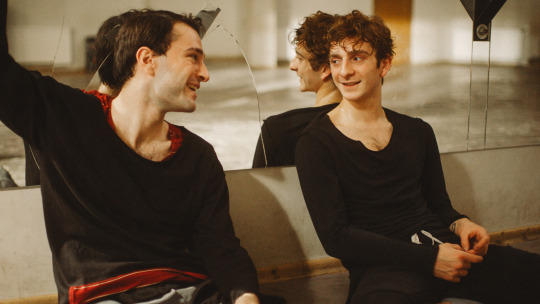
Life in Film: Levan Akin
“Someone told me, ‘You are one person when you make the film, another when it’s over’. And that’s really the case with this film, it’s changed me fundamentally.” —The writer and director of And Then We Danced talks to our London correspondent Ella Kemp about masculinity, queer love stories, Georgian cinema and the ever-quotable joys of Romy and Michele’s High School Reunion.
Love stories come and go, but few have the golden warmth of Levan Akin’s dance-romance, And Then We Danced, which has captivated Letterboxd members enough to garner an impressive 4.0 rating out of 5. The film follows Merab (Levan Gelbakhiani), a dancer who has grown up training at the National Georgian Ensemble, and is moved to examine the structures and traditions he exists within when the charismatic Irakli (Bachi Valishvili) arrives at the company.
Akin was born and raised in Sweden, the son of a Georgian family who emigrated in the 1960s. Following the attacks at the 2013 Pride parade in the Georgian capital of Tbilisi, the solidarity among the country’s gay and queer communities became more urgent. Akin was moved to turn away from the big-budget Swedish TV productions he has made a name directing, in order to connect back to his roots for this project. But And Then We Danced isn’t solely a political commentary—it moves and feels freely.
Akin’s film gives audiences a long-overdue education on traditions far outside Hollywood: we see the rigid rules of Georgian dance, the way a body is taught to bend and extend and survive, and how spontaneous feelings have no place in that education.
If the film, told from such a unique perspective, also feels somehow familiar, it’s because Akin, who wrote, directed and co-edited, is a magnanimous cinephile. He’s been watching and understanding love stories since he can remember, and speaks of them with immense enthusiasm. There are years of wisdom and observation in the details of And Then We Danced. Every time I admit to him I haven’t seen a film he mentions, he looks sincerely happy for me that my world is yet to experience it.
Answering our Life in Film questionnaire, Akin shares memories of ABBA as a national treasure, the first film that blew him away in cinemas as a child, and why Tarkovsky could have done with being a little more queer.
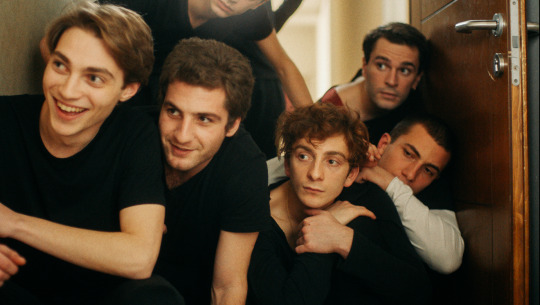
This is quite a departure from the scale of your television projects. What drew you back to Georgia and those difficult circumstances? Levan Akin: I come from a background of making bigger projects, and this wasn’t obviously what a person like me should be doing next. I did a lot of Swedish TV, but I had grown tired of working the way I did. I started working for [Swedish film and commercial director] Roy Andersson when I was 22 and then I went into TV—I never went to film school. I applied twice and I didn’t get in! I was brought up in the SVT [Swedish public broadcasting service] way of making TV series. You have a script, you break it down, sometimes you write it yourself, sometimes you don’t, you do the shot list, you work with the actors, you block the scene and you move on and that’s all fine and good.
But after my previous film I was very tired. I was 36 then, and had sort of forgotten why I was making films. I had seen this Pride parade, the one where they were attacked in Georgia in 2013, and I couldn’t stop thinking about it. So I went to Georgia and did some research with my own little camera, and it very organically developed into this film. I never sat down and thought I’d write a story about this dancer. I used what happened around me, and I found a lot of real people. We often weren’t allowed to film in places a lot of the time—we made up stories about what we were doing. We had to have bodyguards, we’d lose locations on a day’s notice. It was insane, so I couldn’t plan out the movie like I would normally.
I wanted to make a very classical story, a very universal story and have the motor be [Merab’s] first love for Irakli and that setting him free. And then I filled it with things that happened while I was working. I’ve never worked like that, but I think it’s the best film I’ve made, and it’s really been a rejuvenation of my creative energy. Someone told me, “You are one person when you make the film, another when it’s over”. And that’s really the case with this film, it’s changed me fundamentally.
One character in And Then We Danced says, “Georgian dance is based on masculinity”. What are the defining traits of masculinity in Georgia? The definition of masculinity is so different in different cultures. In Sweden, where I live, if two men just hug too much or walk arm in arm, it’s considered super un-masculine. It’s like the whole thing about how young boys fight each other because that’s the only way they can be close in Western society. Whereas in Georgia, you can sit in someone’s lap and it’s not considered gay or un-masculine. Over there, traits like being very poetic, being a dancer, being a good singer, things that might be feminine in our culture are considered very masculine.
I thought that was interesting for the film because the regular story might have been, “I want to be a dancer but my family doesn’t want me to because it’s considered to be a feminine job”. Whereas here it’s the opposite, it’s, “I am a dancer, and I can’t be gay”.
Why was it important to use dance as a narrative vehicle to show these changing identities? What they say in the film is that Georgian dance has evolved. It’s based on old folk dances from different regions of the Caucasus, other Caucasian countries too, as well as Georgia. The dances from Batumi have a lot of oriental influences, originally even more than now. And the Kintouri dance was originally created by a queer group of people who lived in Georgia 100 years ago, and they were people working in service jobs.
Men wouldn’t take those jobs because it was considered unmanly, so the ones who worked in those jobs were gay guys or queer, some were even trans. They developed this dance and it’s sort of like a Paris Is Burning. Everybody knew they were gay. That’s what the teacher says in the film, when he says “they were softer but we made them harder”, because then these dances were appropriated by three big ensembles, and they did alterations to them.

Levan Gelbakhiani in ‘And Then We Danced’.
How did that influence the message you ultimately wanted to share? The film is about finding your own place in a traditional society, and not letting anyone tell you what your traditions ought to be, or how you ought to define yourself, to be accepted as a Georgian. That discourse is all around us now. I’m really frankly tired of people telling me that, for instance, I’m not really Swedish because my parents came from Georgia, and I have a Muslim background. Also, Georgia is 90 percent predominantly Christian Orthodox now, so a lot of Georgians think you can’t be Georgian if you’re not a Christian.
There are two major contemporary music cues in the film—ABBA’s ‘Take A Chance on Me’ and Robyn’s ‘Honey’. How did those two come to be? During the Soviet Union, there was an ABBA concert on TV and I think that was one of the only one Western pop concerts that was broadcast in Soviet. I think it had to do with Sweden being social democratic, and we had sort of a good relationship with the Soviet Union so they thought, “Ok, we can show this, at least it’s not American”. It would be on every New Year’s Eve and it would be like a tradition.
So when the Soviet Union fell, ABBA had a new market with new people who also loved ABBA. So ABBA is actually very popular in Georgia! Of course ABBA is super-expensive to [license], and we had literally no money when we made this film—it was a very hard shoot. But one of the producers of the film is the son of Benny Andersson of ABBA… I figured if he likes the film, for them it’s not a big risk. I thought, I’ll try it in the rough cut and either he’ll like it and say yes or he won’t—but he loved the movie, he was crying afterwards.
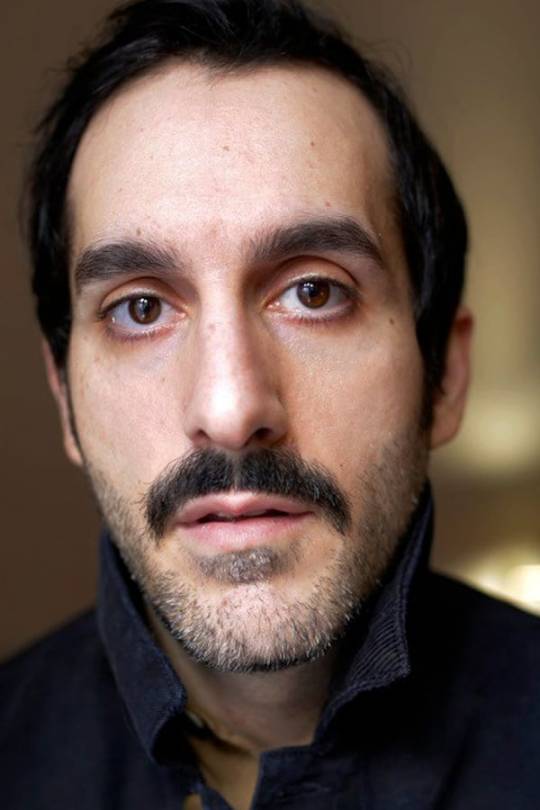
Levan Akin.
I’d also taken a risk with Robyn because that album had just come out, and we all love Robyn. We just hoped she’d like it and accept it, because we couldn’t pay her very much. Thankfully she did, and also we actually got help from Jen Malone. She’s a music supervisor and she’s so talented, and she’s the one who does the music supervision for [bands including] Euphoria, Creed and so on, so once she also got in touch she made it work for us. I’m eternally grateful to Jen.
[The following answers contain spoilers for several of the movies mentioned by Akin.]
And Then We Danced has many beautiful dance sequences. Which specific dance scenes, or dance movies broadly, inspire you? I love The Umbrellas of Cherbourg as a whole, and it has dancing in it, so that’s an easy one. In Dirty Dancing, I love the last dance, I can watch it over and over. It’s an amazing scene in every way. I also love the scene in Ex Machina where [Oscar Isaac] is dancing. It’s so nice, and so sexy.
I don’t know if there was dancing in it but I really want to mention this film—I love The Diary of A Teenage Girl. Marielle Heller is a genius. And Bel Powley and Alexander Skarsgård, they’re just so good in those parts. He was incredible! That should have won all the Oscars. In my films I never have clear antagonists, even if there are characters antagonizing the main character. I love them all, there’s no clear moral compass, everyone is just trying to do their best with the circumstances. It’s the same with this film. I love that you understand and love Alexander Skarsgård, and the guilt Minnie must have been feeling. It’s just so sensitively directed, with such a precise feeling of how to not veer in any one direction. If anyone is just shaking somewhere in that film, let’s put it in this ranking!
There’s this amazing documentary made by a Swedish documentarian, Martha & Niki. It’s about two friends who are dancers, two black girls from Sweden. Their friendship is really complicated, and they’re competing in a special dance, and you just follow them as they’re touring and competing. One of the girls is from Uganda, if I remember correctly, and another one is adopted, so they also have very different social backgrounds. I saw it in cinemas and I was just sitting and crying.
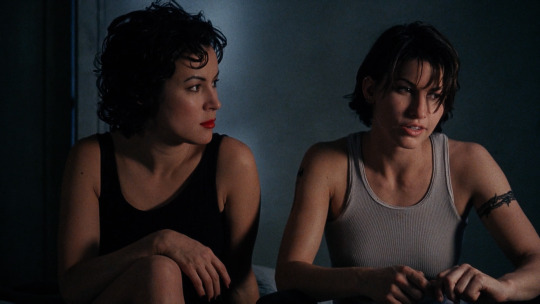
Jennifer Tilly and Gina Gershon in Bound (1996).
What are your favorite on-screen gay love stories? Brokeback Mountain. I saw that movie in New York in 2005 and I was so shocked. I just thought, “What the fuck have I just been through”? The ending… Nowadays, I would never want to kill off a character in a gay movie, but then, it’s so vague that you don’t even know what happens to them. It breaks my heart, it still does.
I really enjoyed God’s Own Country. I thought it was really moving and touching. Josh O’Connor is a revelation, and the other guy [Alec Secareanu] is amazing too. They have great chemistry. It’s just so delicately made.
I also love the Wachowski sisters’ Bound. I remember when I saw it, oh my god. Back then, seeing that was really something. I love Jennifer Tilly, what a star!
In terms of a movie that gay communities really love: Romy and Michelle’s High School Reunion. I’ve seen it literally a thousand times, I just rewind it and watch it again. It’s so amazing. When we were younger, 50 percent of the lines we would say would be lines from that film. It’s hilarious. It’s such a great story about friendship. If you haven’t seen it, congratulations, you have so much to look forward to!
And how did I almost forget My Own Private Idaho?! I saw that as a kid in the 90s, and it’s just so amazing. River Phoenix. What a movie.
Could you give the Letterboxd community a primer to some great Georgian films? I love My Happy Family, a film by Simon Groß and Nana Ekvtimishvili. They’re a directing couple. They did another film called In Bloom; about a teenage girl, it’s sort of autobiographical I can imagine, as it feels very lived. It’s about a Georgian girl in the 90s. Both films were at Sundance—My Happy Family was there three years ago and I think it won an award. [It was nominated for the Grand Jury Prize, and was Georgia’s entry for the 2013 best foreign language Academy Award]. Netflix bought it, so it’s on there now.

My Happy Family (2017).
It really shows this thing in Georgia where there is no private sphere. Families live together inter-generationally for life for many reasons—financial ones for sure. It’s the story of this woman who lives with her mother, her father, her children, everybody is in that house. She decides that one day she wants to move into her own apartment, and it’s the most shocking thing anyone has ever heard of. She says she just wants to sit alone and read books and have her own space, and everyone is so provoked by that because that can’t happen in Georgia.
There’s another Georgian film I love called Street Days, by Levan Koguashvili, which came out in 2010. It was one of the first new-generation movies in Georgia showing the reality of Georgia the way it was then. It’s the story of a man who is struggling to support his family, but he’s also a drug addict. It sounds really bleak but it’s made with such dark humor.
To go really far back to the directors working through the Soviet time, there’s The Wishing Tree by Tengiz Abuladze. So many shots from that film are so, so beautiful. It’s set in the rural parts of Georgia, and it’s about a young girl who falls in love with a boy, but they can’t be married because she has to marry an older person because it’s better for the family. And the boy she was in love with was killed by the husband. She goes insane, because she keeps thinking about it all the time; she’s talking to his ghost. This old woman in the village hears her and thinks she’s cheating on her husband, so they decide to do this ritual where they stone her. It’s so sad and so beautiful, and there’s a woman in the village who’s like the town fool but she’s the only one making sense. It’s so poetic.
Sergei Parajanov is another of my all-time favorite directors—I love The Color of Pomegranates and Ashik Kerib. He’s a great surrealist director and has inspired many directors since, such as Tarsem Singh and Mark Romanek, who did a lot of music videos in the 90s. Madonna’s video for ‘Bedtime Stories’ was really inspired by Parajanov. He worked a lot with tableaux, and it’s so queer. [Parajanov] was gay and he was imprisoned for it many times. He was very close friends with [Andrei] Tarkovsky and he attributes his artistry to being inspired by him, saying that Tarkovsky released his creativity. They were close, but they’d also fight a lot. One time Parajanov told Tarkovsky, “You can never be as amazing a director as me, because you’re not a homosexual”, which is funny!
Finally, what was the film first made you want to be a filmmaker? I love that question. It feels like I’m closing a circle because I think the movie I’m thinking of has some similarities with my movie. It’s Some Kind of Wonderful, [written] by John Hughes and directed by Howard Deutch. It’s not one of the most famous John Hughes movies but it’s one of the first ones I saw in the cinema. I think I was seven years old, I went with my older sister who was eleven at the time.

Mary Stuart Masterson and Eric Stoltz in ‘Some Kind of Wonderful’ (1987).
It’s a love triangle between Eric Stoltz, Mary Stuart Masterson and Lea Thompson. Stoltz plays this working-class kid, he lives on the wrong side of the tracks, the classic perspective that’s always in John Hughes movies. He’s in love with the popular girl in school, Amanda Jones. She is also from his part of the town but is dating the rich guys. He’s really in love with her, and his best friend is played by Masterson, she’s called Watts but her nickname is Drummer Girl, and she’s a tomboy. When I was little I thought she was a boy who was a gay character. I didn’t understand that she was a girl because I’d never seen a girl like that as a kid. It’s just a great movie, it was a love triangle before love triangles were boring. I don’t know if it consciously made me want to direct films, but it was the first film that I saw that that stuck with me.
We didn’t have a lot of movie culture in my house, my parents emigrated to Sweden in the late 60s. My father read a lot, but we didn’t come from any culture. The films I’d find were the ones you could rent in the local store. Mostly American movies. The more highbrow stuff came later when I was older and could search them out myself.
‘And Then We Danced’ premiered in Director’s Fortnight in Cannes last May, and has won several prizes at other prestigious festivals since. The film is currently showing in select cinemas on the east and west coasts of America, and opens in UK cinemas on March 13.
#levan akin#and then we danced#dance films#dance movies#georgia#georgian cinema#tibilisi#lgbt#queer cinema#gay cinema#gay filmmaker#swedish film#swedish cinema#ella kemp#dirty dancing#letterboxd
16 notes
·
View notes
Text
The Thorny Road to the 19th Amendment
https://sciencespies.com/history/the-thorny-road-to-the-19th-amendment/
The Thorny Road to the 19th Amendment

When the 19th Amendment became law in August 1920, it constituted the largest simultaneous enfranchisement in American history—women nationwide had finally obtained, at least on paper, the right to vote. But it’s the struggle for suffrage, which stretched more than 75 years prior, and not just the movement’s eventual victory that UCLA historian Ellen Carol DuBois recounts in her new book, aptly titled Suffrage: Women’s Long Battle for the Vote.
Suffrage history is thistly and complicated. The movement got its start in abolitionist circles during the mid-19th century when most married women lacked basic property rights. Even among the progressive-minded women and men gathered at Seneca Falls in 1848, the notion that “it is the duty of the women of this country to secure to themselves their sacred right to the elective franchise” proved radical. “One of my intentions,” DuBois told Smithsonian, “is to integrate the history of the women’s suffrage movement into American history…At every stage, the larger political atmosphere, the reform energies of the 1840s and ’50s, the Civil War and Reconstruction, the period of Jim Crow, the Progressive Era and then World War I, each of those periods creates the environment in which suffragists have to work.” To that end, DuBois traces the ways in which Reconstruction fueled calls for “universal suffrage” as well as a racial schism among suffragists. We learn how the women’s rights advocates became (sometimes uneasy) allies with different political parties, Temperance advocates and the labor movement and how outside political turmoil, like World War I, complicated their quest for the vote. Centuries before social media and the internet, reformers turned to newspapers, speaking tours, and eventually advocacy that ranged from signature-gathering to hunger strikes to convince voters and legislators alike how imperative it was that women gain the franchise.
DuBois’ richly detailed account also doesn’t shy from examining the bitter divides that fissured the suffrage movement over methods, race and class as it struggled to piece together a coalition that would vote to let women vote too. In the 1870s, after a schism between prominent suffrage leaders over supporting the 15th Amendment, the movement split into several camps, one with more moderate tactics and Republican Party allegiance than the other; in the 1910s, a similar split emerged between the more militant NWP and conciliatory NAWSA. And despite the contributions of women of color like Ida B. Wells-Barnett and Mary Church Terrell to their cause, NAWSA adopted an “explicitly racist policy” to appeal to Southern states around the turn of the 20th century, DuBois writes.
Intermixed in all this political history are the miniature profiles of the remarkable, determined women (and choice male allies) who propelled the suffragist movement. Susan B. Anthony ranks among the best known, but DuBois also adds the lesser-known facets like that Anthony was formally tried and found guilty of casting a ballot “without having the lawful right” to do so in New York? DuBois also highlights the stories of suffragists with less name recognition, like the firebrand and Equal Rights party presidential candidate Victoria Woodhull, Woman’s Christian Temperance Union leader Frances Willard and millionaire benefactress Alva Belmont. DuBois spoke by phone with Smithsonian about her book:
This book covers a long history, and I’m curious about the evolution of the movement. What are some of the twists and turns the fight for suffrage took that were not part of the original vision?
First, what really makes the suffrage movement the foremost demand of the women’s rights movement are the consequences of the Civil War. The U.S. Constitution has almost nothing to say about who votes until the 15th Amendment, [which enfranchised African American men]. In the early postwar years, the assumption was that, like economic rights, voting rights would have to be won state by state.
Then with the 13th, 14th and 15th Amendments, which virtually rewrite the U.S. Constitution [to abolish slavery and give formerly enslaved people legal and civil rights], the suffrage movement focuses on getting the right for women to vote acknowledged in the Constitution. When efforts to get women included in the 15th Amendment failed, suffragists actually returned to the state level for the next many decades.
The suffragists go back to the states, almost all of them west of the Mississippi, and convince male voters to amend their state constitution to either remove the word “male” or put the right of women to vote in those constitutions. Here is the crucial thing to acknowledge: When that happened, first in Colorado, then in California and ultimately crossing the Mississippi to New York in 1917, those women who were enfranchised by actions of the state constitution had comprehensive voting rights, including for president. So for instance, the women of Colorado gained the right to vote in 1893; they voted for president five times before the 19th Amendment is passed. By the time that the suffrage movement moves into high gear, in the midst of the first World War and then immediately afterwards, four million American women have the right to vote for president.
The way that the right to vote moves back and forth from the state to the federal level is something that could not have been anticipated. Especially since those first suffragists really thought that in the sort of revolutionary change of emancipation and black male enfranchisement, surely women would also be included. The failure of the 15th Amendment to extend the franchise to women so enraged a wing of the women’s suffrage movement that it broke open the alliance between black rights and women’s rights groups with serious and negative consequences for the next half century.
The second thing I’d say is that when women’s suffrage started, the political parties were quite infant. Indeed, the women’s suffrage movement begins before the Republican Party comes into being. I don’t think that suffragist reformers really anticipated how powerful the major political parties would be over American politics. One of the things I discovered in my work was how determined the controlling forces in the major parties, first the Republican and then the Democratic Party, were to keep women from gaining the right to vote.
Why was that?
When the Republican Party enfranchised African-American, formerly enslaved men, almost all of whom lived in the South, they anticipated correctly that those men would vote for their party. The enfranchisement of women was so much greater in magnitude, so there was no way to predict how women would vote. Really up almost till the end of the suffrage movement, American women had a reputation, gained or not, for being above partisan concerns and sort of concerned with the character of the candidate or the nature of the policies, which meant that they could not be corralled into supporting a partisan force. So the only parties that really ever supported women’s suffrage were these sort of insurgent third parties who had nothing to lose and everything to gain by attaching themselves to a new electorate. The most important of these was what was called the People’s, or Populist, Party of the 1890s. Those first victories in the West can be credited to the dramatic rise of the People’s Party.

Suffragists wearing the names of some of the Western states that had already granted women the right to vote process down Fifth Avenue during a 1915 march.
(Bettmann via Getty Images)
How did the women’s suffrage movement move from being very closely tied to abolitionism to largely excluding women of color?
So there were a couple things. First, Elizabeth Cady Stanton, one of the dominating figures in the first half century of the movement, when she’s really enraged not just that women are excluded from the right to vote but women like herself are excluded from the right to vote, she expresses herself in ways that are…she’s charged with being racist. I think it’s more accurate to say she’s an elitist, because she’s as dismissive of European immigrants as she is of the formerly enslaved.
Stanton made really, really terrible comments about people a generation removed from slavery—she called them the sons and daughters of “bootblacks” or sometimes she called them “Sambo.” Sometimes that charge of racism flows over to her partner Susan B. Anthony. That’s not really fair. Anthony’s abolitionism was much deeper and more consistent. When you follow her career, until the day she died, she was always, wherever she went, she would make sure that she went to black churches, black universities, black societies.
Second, by the turn of century we’re moving into a whole different generation of leaders, none of whom have any roots in the abolition movement, who come of age during the period in which Reconstruction is portrayed as a terrible disaster for the nation and who are part and parcel of the white supremacist atmosphere of the early 20th century.
In those final eight years, 1912 to 1920, when the suffrage movement breaks through for a variety of reasons, to a real chance to win a constitutional amendment, the U.S. government is controlled by the Democratic Party. The president is a Southern Democrat. Washington, D.C., the home of the federal government, is a southern city. So the political atmosphere is radically hostile, at the national level, to anything that will help to return the African American vote.
In all the research you did for this book, was there anything that surprised you?
I was incredibly impressed by the congressional lobbying. I don’t think I appreciated, until I wrote this book, the quiet importance of Frances Willard and the WCTU, which doesn’t really fit into our normal story of suffrage radicalism. This sort of conventional women’s organization was important in bringing mainstream women, and not just the kind of radicals who had fought for the abolition of slavery, to recognize the importance of votes for women to achieve their goals, not just because these were high principles of equal rights, but because they couldn’t get what they wanted done. Whether it was the prohibition on alcohol or the end of child labor, they couldn’t do those things without the vote.
One of the lessons of the book is that the notion that women’s suffrage was a single-issue movement is just wrong. All of them had other goals. Carrie Chapman Catt was interested in world peace. Alice Paul was interested in equal rights for women beyond the right to vote. Anthony was interested in women’s right to earn a living. Stanton was interested in what we would call reproductive rights for women. Each of them had a larger vision of social change in which women’s suffrage was fundamental as a tool.
#History
2 notes
·
View notes
Photo

PMCs – a Lifeline that Protects US Interventionism If we examine USA’s foreign policy, it becomes apparent that the nation has been at war with one nation or another, or even several countries at once, 50% of the time over the past 50 years. If we take into account all the US military interventions, then, even according to American media outlets, over the past 25 years, the United States has carried out air strikes against at least one nation per year. And since its invasion of Panama in 1989, the USA has been, almost constantly, conducting military operations abroad. Thus, the common man from Iowa or Texas needs to don an army uniform and travel to the distant lands in order to defend “democratic values”. Nothing seems to have changed since The White Man’s Burden poem was published. Many of these men return home in a casket wrapped in stars and stripes. And politicians who sent them to war need to then explain to American people why they have to sacrifice their sons’ and daughters’ lives for the sake of little-understood geopolitical games. And with each passing year, it is becoming increasingly harder to do so. Unfortunately, neither the number of military conflicts, initiated by Washington, nor the number of American soldiers dying in these interventions in Afghanistan, Iraq or Syria has reduced over time. Presidential candidates who give speeches about ending armed confrontations or withdrawing US troops from foreign soil during their election campaigns do not follow through on their promises. Then, the next presidential election nears and candidates announcing their future plans do actually need to do something. Hence, it is not surprising that, recently, President Donald Trump, who had also promised to put an end to military confrontations in Syria, Iraq and Afghanistan earlier and to even withdraw American troops from certain nations, decided to try and “contribute” to the resolution of conflicts in the Greater Middle East by replacing traditional US troops with personnel from private military companies (PMC). After all, operations under a “foreign flag” will allow the United States to steer clear of direct military and technical cooperation, illegal provision of supplies and training of “opposition” troops. In addition, if civilians in Afghanistan, Syria or Iraq are brutally killed by American soldiers, many unnecessary political issues arise, but if former US servicemen on the payroll of PMCs do the same, such problems are mainly “commercial in nature”. In the end, as Afghanistan, Iraq, Libya and other nations started to demand, more and more actively, that the USA and Western nations remove their troops from their territories, Washington (and then London) began to replace them with “independent” PMC experts, all the while talking about withdrawing their forces in public. Still, substituting American military units with private military companies is not a new occurrence. DynCorp, the first US PMC, “traces its origins from two companies formed in 1946: California Eastern Airways (an air freight business), and Land-Air Inc. (an aircraft maintenance company)”. Shortly after it was established, DynCorp signed a contract with the US Department of Defense. More recently, the key corporation to earn the euphemism “private army” has been the Blackwater Security Company (BSC). The name of this US PMC is associated with the most notable precedents involving the use of private security forces, and with the geopolitical reasons why the mercenary trade was reborn in the 21st century. In 2003, immediately after invading Iraq, Washington established a transitional government (the Coalition Provisional Authority, CPA) there, headed by Paul Bremer, an American “diplomat”, who hired Blackwater personnel for security purposes. Their contract and work in Iraq served as the first precedent when a civilian as well as head of the occupying power hired a “decently-sized army” for his needs. After the Cold War had ended, PMCs took part in several armed conflicts in Africa. Americans from private security firms trained the Croatian Army during the Yugoslav Wars while Israeli private military companies helped prepare Georgian servicemen for armed conflict. It is not an exaggeration to say that PMCs have become modern equivalents of mercenary units, which began their existence a long time ago, when the first nation states were being established. As a rule, mercenaries are primarily motivated by hard cash and not by political, ideological or national aspects of a war that they participate in. Quite frequently, the hired guns are not citizens of nations where armed confrontations take place but this is not always true. There is another important consideration to be taken into account. Private military companies are a true symbol of hybridization of modern warfare. Hybrid conflicts allow a nation to not only hide the actual numbers of military causalities from its own people but also, if necessary, play “dumb” and conceal its involvement in any given confrontation. Nowadays, the United States, along with a number of other Western countries, is increasingly “outsourcing” its military operations. For instance, during recent peacekeeping missions private military companies, at the behest of Washington, have been treated as entities whose rights are equivalent to regular army units. It is important to understand that modern PMCs are not anything like the hard-boiled hired guns of the 1970s-1980s in Angola and Mozambique. At present, private military companies receive funding from the richest Western corporations; have close ties with the political establishment of Western nations, and are quite often headed by former high-ranking officials or retired generals. Western private security firms are entities rigidly controlled by a government that operate in the latter’s interests. This is the main difference between modern PMCs and mercenary units from the Middle Ages. In theory, the responsibility for a PMC’s actions (as well as any violations committed by it) lies with the government that has hired this particular firm. However, as a rule, the responsibility is not clear cut and it is far easier to shirk it than in cases of crimes committed by a “traditional” army. In the nearest future, the number of private military companies will surely only rise world-wide, after all, it is truly advantageous to outsource “military operations”. In fact, at present, the number of security staff from PMCs in Afghanistan and Iraq exceeds that of American servicemen in these nations. And even the Pentagon would most likely find it difficult to estimate the exact number of such mercenaries.
1 note
·
View note
Text
Becoming Robert DeNiro
We are told (more re: this comment later) that Robert Deniro is an only child, his mom is an atheist and a far left lib, his father is also a far left lib and left his wife and son for another man! His mom and dad both were "artists" and wrote "erotica" for Anaïs Nin who was a novelist who also wrote "volumes of erotica".

They were part of an artistic community that was an “underground community” bursting with vitality and gossip, with its own celebrations and myths.” His parents had a “salon” on Bleecker Street and people such as “art critic Clement Greenberg, film essayist Manny Farber, and artist Margaret McKee, among others, would drop by and discuss Freud, Kierkegaard, Gertrude Stein, or Zen.” By all accounts they were a poor family.


His mother, Virginia Admiral, was English/French/Dutch/German. She was born in Oregon, lived in Illinois, (NOTE: her living in Illinois is important later) and then Berkeley, CA. She was "part of an off-campus art, socialist, and literary scene." Per Geni.com she was residing in Danville, Illinois according to the census, with her parents and younger sister, Eleanor. By 1930, Virginia's parents had divorced and she was living with her mother and sister in Berkeley, California. While in Berkeley, her mother, Alice, became a school teacher. Admiral, a painter, met Robert De Niro, Sr., an aspiring artist, at one of Hans Hofmann's painting classes in Provincetown, Massachusetts, and they married in 1942. https://www.geni.com/people/Virginia-De-Niro/6000000010581882947

According to Geni,com, his maternal grandfather lived in Illinois until 1930 at which point the census shows him living in Berkeley, CA. This is when his maternal grandparents divorced. His mother did not meet his father until 1942 in Massachusettes and Robert was born in 1943. His maternal grandmother, Alice Groman, shows to have died in 1962 in Indiana. His Maternal grandfather shows to have died, per the census, in 1949 in Palm Springs, CA.
https://www.geni.com/people/Donald-Admiral/6000000010581851011

His mother’s aunt, Helen Admiral, was born 1881 in Danville, Illinois and died 1914 in Chicago, Illinois. His mother’s uncle, Holton Admiral, was born in Watseka, Illinois in 1882 and died in 1952-1973 and location not known. His mother’s aunt, Virginia Dady, was born in Indiana in 1886 and died in Harvey, Illinois in 1955.
Her grandfather, Nicholas Admiral, was born in 1853 in Noor-Holland, Netherlands and died 1918 in Livingston, Illinois. Her grandmother, Virginia Mosbey Admiral, was born in 1848 in Falmouth, KY and died in 1928 in Clackamas, OR. Her great grandfather, Jacob Admiral, was born in 1818 in Netherlands. Her great grandmother, Neeltje Bakker, was born 1828 in Netherlands.
Her great grandfather, Nicholas Mosbey Holten, was born in 1807 in Mason, KY and died 1887 in Danville, Illinios. Her great grandmother, Lucy Ann Dupuy, was born in 1795 unknown and died 1849 unknown.
His mother’s family is far more extensive and goes way back to 1300′s in England

His mother has one sister, Eleanor Elizabeth Admiral Haefle. She was born 1916 in Iowa, 1920 lived in Illinois, 1930 -2009 died California.
Since it is likely his parents married because of the pregnancy, they divorced when he was about 2yo and his father began a homosexual relationship with his mother's longtime, very close friend Robert Duncan. Duncan was born to a family of devout theosophists (religious movement introducing the occult to Western esotericism, based on Neoplatonism and Asian religions such as Hinduism and Buddhism.

He was surrounded by the occult during his childhood. He studied at Berkeley and wrote poems based on his "left wing politics and was a friend of Deniro's mother. He was a member of the Mattachine Society which was founded by communist Harry Hay from LA. He studied "Medieval & and Renaissance literature and cultivated a reputation as a shamanistic figure in San Francisco poetry and artistic circles."

"His name is prominent in the history of pre-Stonewall gay culture and in the emergence of bohemian socialist communities of the 1930s and '40s, in the Beat Generation, and also in the cultural and political upheaval of the 1960s, influencing occult and gnostic circles of the time."

Deniro’s father was an artist and was involved in abstract art. He was born in Syracuse, NY and was Italian/Irish American. His father studied with Hans Hofmann at his Provincetown, Massachusettes summer school where he was taught Abstract Expressionism and Cubist formalism. This had a strong influence on his father’s development as a mature artist.

Per Geni.com, his father was born in 1922 in Syracuse, NY and died in 1993 in NY, NY due to prostate cancer. His grandfather, Henry Martin DeNiro, was born in 1897 in Ferrezzano, Molise, Italy and died in 1976 in Syracuse, NY. His grandmother, Helen M. O’Reilly-DeNiro was born in 1899 in Syracuse, NY and died in 1999 in Syracuse, NY.

His uncle, John DeNiro, was born 1925 in Syracuse, NY and died 2000 in Syracuse, NY. His aunt, Joan DeNiro-Bauder, was born in 1926 in Syracuse, NY and died 2017 in Syracuse, NY. His aunt, Elizabeth DeNiro, was born in 1928 in Syracuse, NY and died 1999 in Syracuse, NY

His great-grandfather, Giovanni Di Niro, was born in Italy. His great grandmother, Angiolina Mercurio, was born in Italy. His great-great-grandfather was Luigi Mercurio and was born in Italy. His great-great-grandmother was Rosanna Alaura also born in Italy. His other great-great grandfather, Carmine Di Niro, was born in Italy. His other great-great grandmother, Francesca Di Niro (Notartomaso) was born in Italy.

His great grandfather, Dennis Francis O’Reilly, was born in 1866 in Syracuse, NY and died 1952 in Syracuse, NY. His great grandmother, Mary O’Reilly, was born 1868 in NY and died in 1924 in unknown. His great-great grandfather, Edward O’Reilly, was born in Ireland. His great-great grandmother, Margaret, was born in Ireland.
So Robert DeNiro, Jr is half Italian and half Irish on his father’s side. This explains his dark hair and eyes but pale skin which lead to his mob nickname, Bobby Milk.
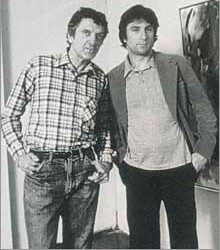
Much of DeNiro’s life did not include his father, and while the actor paid homage to his father at his 74th birthday, it appeared to be an emotional upheaval of regret. By looking at his father’s art, one can describe it subpar at best, and likely visions derived from an LCD rendezvous. While Deniro was very wealthy, his father remained poor. The story is his father was very involved in Deniro’s life, but considering he spend most of his life in Paris makes that hardly believable. But, we’ll let Deniro have his “memories”.




His uncle, John “Jack” Deniro died in 2015 and lists Robert and his wife Grace as his nephew. There are many pictures there of the family and several I put here with Deniro: https://www.remickgendron.com/obituaries/John-De-Niro/#!/Obituary





His cousin, Jean DiNero was the production assistance for “Raging Bull” and several other shows: https://www.imdb.com/name/nm0210585/
She lives in Manhattan, NY and married to Candace Sue Frede:
https://www.nytimes.com/2002/11/10/style/weddings-celebrations-jean-deniro-candace-frede.html
His cousin, Linda DeNiro lives in NY and is a licensed realtor in NY and FL as well as an interior designer: http://lindadeniro.com/about

His cousin, Dana DeNiro-Moulton lives in NH and owns a fashion boutique: https://lunachics.com/meet-our-staff-1

It appears his extended family are likely liberal but not involved in the sadistic pedophilia that Robert is dabbling in. Anyhow, back to the woman his parents wrote "erotica" for, Anaïs Nin, dropped out of high school at age 16 and became an "artist's model". She married Hugh Parker Guiller aka Ian Hugo, a filmmaker who did "experimental film" but eventually went into banking.

She also hooked up with Otto Rank, a close friend of Freud x20+yrs also a psychoanalyst, and she began to practice psychoanalysis in a room next to his by having sex with her patients on her psychoanalytic couch. She is "hailed by many critics as one of the finest writers of female erotica". Anaïs Nin eventually moved to LA. She was hailed by the feminazi movement and gave many lectures.

It is also said that she was bi-sexual. She had a long standing love affair with Henry Miller, an American writer who developed "a new type of semi-autobiographical novel that blended character study, social criticism, philosophical reflection, stream of consciousness, explicit language, sex, surrealist free association, and mysticism" and was an active member of the Socialist Party of America.
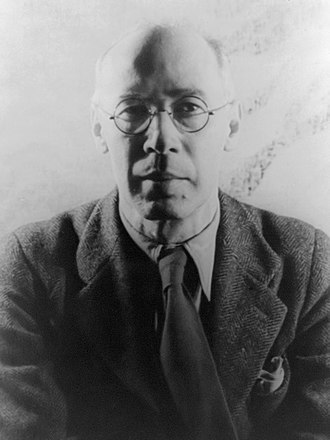
His book "Moloch: or, This Gentile World" is a semi-autobiographical novel originally said to be written by his wife June but it is "considered to be of interest more as a study of Miller's artistic growth than as a worthy piece of fiction". His work was very detailed descriptions of sexual encounters.
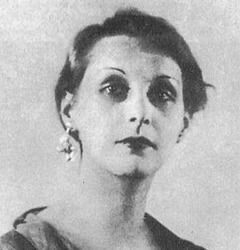
He was a pedo who liked much younger girls, marrying several of them. He also lived in LA and worked with Warren Beatty and had parties at his home for the artistic elite.


So, we have an idea of the upbringing Robert DeNiro had with socialists, communists, abstract art, erotica, Atheism, homosexuality, bisexuality, broken home, elitist environments, and MKULTRA (keep reading). His parents were not very involved in his life so he was left unsupervised often. He spent a lot of time with the homeless street kids. Per a family friend, “he wasn’t coddled much”. (sounds like MKULTRA conditioning- lack of attention and affection)

He was an introvert, very shy, and spent hours in silence. During his time alone, which was a lot, he wondered the streets of Little Italy in NY. “After school he took to wandering around the streets of Little Italy, past the sleazy bars and pool halls, and he joined a street gang on Kenmare. Gang members nicknamed him Bobby Milk, “because he was pale and strange as milk.” (Below he seems to be in a trance-like state)

When he was 16, he dropped out of high school. He had taken acting classes at “Stella Adler’s scene-study class.” after performing at the age of 10 in a school play as the Cowardly Lion in The Wizard of Oz.

In 1975 he explained that while his initial desire to act was for stardom, he eventually liked, “To totally submerge into another character and experience life through him without having to risk the real-life consequences—well, it’s a cheap way to do things you would never dare to do yourself.”
https://www.vanityfair.com/news/1987/10/robert-de-niro-life-story

Stella Adler was born in 1901 to a Jewish family, all of whom were actors. Her mother, Sara ( Sara Heine), was a Russian-born Jewish actress. She moved to NY in 1883 with her husband, Maurice. She spoke only Russian but learned Yiddish in the theaters. She married Jacob Adler in 1891 and, “She and Adler would be among the most prominent actors in Yiddish theater in New York for the next three decades.” https://en.wikipedia.org/wiki/Sara_Adler

Her father, Jacob ( Feivel (Pavel) Abramovitch Adler), was born in what is now known as the Ukraine. He had very little education, spent much time on the streets with petty crime, got into boxing, starting dancing, and eventually starting acting. He was a socialist. He had an affair with Jenny "Jennya" Kaiser and had Stella’s brother, actor Charles Adler. She is also sister of Luther Adler and cousin to Jerry Adler. https://en.wikipedia.org/wiki/Jacob_Pavlovich_Adler



Stella Adler started acting alongside her parents when she was 4. “The Adlers comprised the Jewish American Adler acting dynasty, which had its start in the Yiddish Theater District and was a significant part of the vibrant ethnic theatrical scene that thrived in New York from the late 19th century to the 1950s.” Much like her father, she had very little formal schooling and spent much of her time in the “theater”.

I am sure you wonder why I am detailing these people. Well, it appears by the many descriptions of their “art” that this may have been the early MONARCH MKULTRA institutions where children were brought in (remember, they preyed on children from broken homes or ones who had limited parental involvement- which is the case with Deniro) and brainwashed/controlled. This makes perfect sense now that we understand the means to mass brain control is through the media/movies/music. Acting studios make a perfect front! Take a look at the diagram below:

Stella joined a theater called Group Theater founded by Russian/Jewish actors/directors who had close ties to the Russian actor, Konstantin Stanislavski, from Moscow. It isn’t far fetched to assume they had ties to communists, more about that below. This theater began as the Actors Studio, a membership only theater that eventually became the Group Theater which used the strict practices called, The Method, derived from Stanislavski. Note: “Adler made her English-language debut on Broadway in 1922 as the Butterfly in The World We Live In.” (How MONARCH of them!)
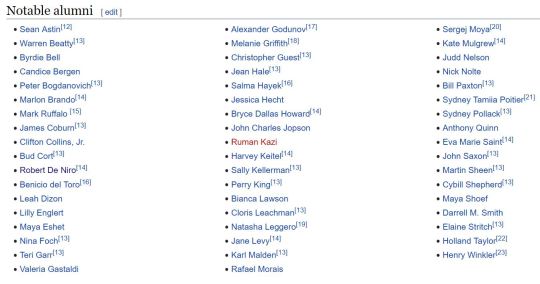
The Method, diagram above, refers to a strict process in which the actor becomes the part they are playing. There were “three teachers associated with "having set the standard of its success", each emphasizing different aspects of the approach: Lee Strasberg (the psychological aspects), Stella Adler (the sociological aspects), and Sanford Meisner (the behavioral aspects).” https://en.wikipedia.org/wiki/Method_acting

This group was led by Lee Strasberg and are connected to Yale Acting School and had great influence on the Chelsea Theater Center in NY. Remember, this is during the “McCarthy” era when everyone called him a “conspiracy theorist” regarding all the communists residing in America. In the 1950′s, many of the former members were called to testify in front of the House Un-American Activities Committee (HUAC). Several turned over on their communist leaders and connections: Elia Kazan, Clifford Odets, and Lee J. Cobb. Deniro says:

How “Crime Boss” of him! No chance he’s gonna sing like a canary. One of the people who exposed the communist ties to the group, Elia Kazan, said, “he abandoned his Communist views in part because of an agenda to transform the Group Theatre into a company devoted to promoting "Marxist ideology."
Look again at the names in this pic:

Lee Strasberg was born, Israel Lee Strassberg, a Polish-American. He is known in Hollywood circles as the "father of method acting in America". His third wife started the Lee Strasberg Theatre and Film Institute in New York City and in Hollywood. It continued the teaching “system”. Per Wikipedia: “The institute's primary stated goal was "to reach a larger audience of eager and emerging talent" than was served by the Actors Studio's notoriously selective admission process, and as teachers of the method began to deploy their own personal interpretations of the discipline, "to dispel growing confusion and misrepresentation of the method, preserving what had by now become fundamental discoveries in actor training."

The Lee Strasberg Theatre and Film Institute has its own rigorous sets of entrance criteria required for admission into their program and “Kazan, in his autobiography, wrote, ‘He carried with him the aura of a prophet, a magician, a witch doctor, a psychoanalyst, and a feared father of a Jewish home, was the force that held the thirty-odd members of the theater together, and made them 'permanent'” The actors and directors who were programmed, trained, brainwashed, whatever you wanna call it, are now doing the selecting of subjects and programming today (Ellen Burstyn, Al Pacino, and Harvey Keitel lead this nonprofit studio dedicated to the development of actors, playwrights, and directors.” https://en.wikipedia.org/wiki/Lee_Strasberg

As you can see, this is a whole other rabbit hole we need to jump down. MKULTRA is alive and well and has been working behind the guise of teaching acting. It makes sense, though, because isn’t acting a time when you become who you are told to be? Why do these actors perform their roles so well??? Because they ARE those roles! Their souls were abducted at a time they could not refuse and now they are running rampant in our society pretending to be one of us! Note the names identified above: Abromovitch and Marx.
Now that I have got your attention, get a drink...go pee...definitely pray...and give yourself some time to digest this chaotic, yet well orchestrated, evil mess before you start the next section which explains how the Mob ties into this whole shindig! Oh yes, Patriots, there is MUCH MUCH more! Muwahahahahahah!

So Deniro was sucked into the MKULTRA program as a young child. He was cultivated to operate for the Kabal and to do as he is told. He has no soul, as his precious soul was abducted long ago. He is a master of acting because, like the Matrix, he gets “plugged in” and “becomes” his role. His shadow is cold and dark. But, when and where and to whom was he conceived?
He was known as a womanizer and a partier who did drugs with many of the elite he worked with. He was known to be a d!ck to people he felt were subpar actors but this is noted about him, "De Niro was too obvious with his frustration with the actress cringing at her line readings. But he treated Jodie Foster, only 13 at the time, like a queen."

He spent a lot of time at the Chateau Marmont hotel where many elite stayed and partied including John Belushi and Scorsese, with cocaine their favorite drug. He is said to have had relations with @BetteMidler, Sally Kirkland, Carole Mallory, Helena Springs, and actress Barbara Carrera while he was still married to his first wife Diahnna (Toukie). It seems he attempted to land any woman who would let him...so he’s made his rounds in Hollyweird.



He has 6 children and in his old age has slowed down his partying but he has accumlated Quite a bit of wealth, even by Hollyweird standards and has acquired much real estate in NY and LA. Most importantly and equally intriguing...he is known as a frequent visitor of the Chateau Marmont Hotel in LA which is considered the Elite party spot where "anything goes" and he along with Robin Williams were there the night John Belushi "accidentally" OD'd on heroine and cocaine.


Remember, this is the same hotel @RepAdamSchiff is "suspected" to have dressed in drag and raped the 10yo child they "accidentally" killed by overdosing him with heroin then disposed of his body...and that Anthony Bourdain was there and "suicided" himself shortly after (@Johnheretohelp). Seems DeNiro is closely linked to this hotel alon with many other actors for many years, since the 70's.
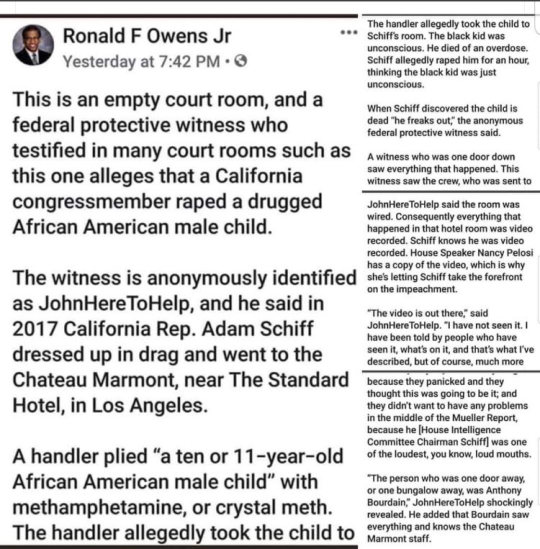
His acting career started with a very close relationship with Scorsese. Deniro and Scorse grew up in Little Italy in NY together and DeNiro was part of the Kenmare gang. This is considered a "tame" gang but he did grow up in the area of NY where all the BIG crime families were. "De Niro has also been connected by some to the Gambino crime family."

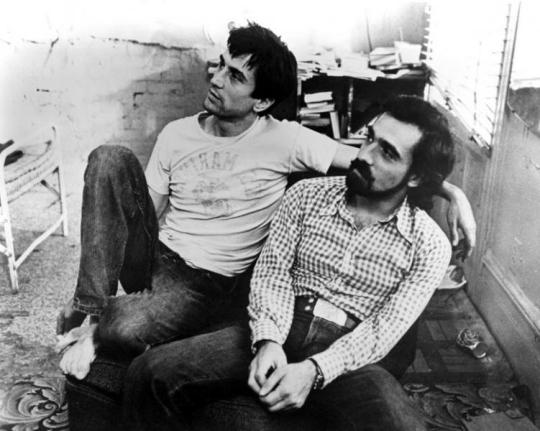

De Niro is one of the "GoodFellas" actors to hang out members of the Gambino family, "De Niro consulted with the late Gambino soldier Anthony (Fat Andy) Ruggiano for is role in "Analyze This". Ruggiano was involved in at least seven murders, including his son-in-law.

Frank Sivero "posed for photos at Gambino hit man Charles Carneglia's junkyard, and actor Anthony Borgese was indicted for participating in an extortion with a Gambino soldier." DeNiro introduced to Gambino by Anthony Corozzo a Gambino associate AND mbr of Screen Actors Guild!

Gambino boss, Nicholas "Little Nick" Corozzo, is brother to Anthony. Their two brothers: Joseph "Jo Jo" Corozzo a Gambino consigliere and Blaise Corozzo a Gambino soldier. The Gambino family is connected to the Screen Actors Guild! There is a long history of mobs and Hollyweird.

De Niro claims he does not remember meeting Ruggiano because it was so long ago: https://www.thechicagosyndicate.com/search/label/Anthony%20Corozzo?m=0
Denior has been seen photographed with sketchy characters we know worship satan, do spirit cooking, kill and eat babies while sacrificing them to their pagan gods. The #1 witch in particular is MARIA Abromovitch. (Notice that name is bolded above), Bill Clinton, and Jay Z.

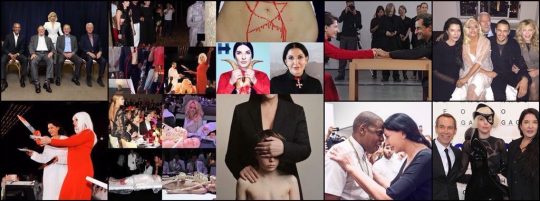

Deniro was a part of the Harvey Weinstein collapse because Harvey took "very young" girls to Deniro's restaurant Tribeca Grill and even assaulted the employees there too. Hey Bobby Milk, ur friends define you...didn't you know that???


Recently he was found attending functions with Purple Magazine (connected to Rachel Chandler) and posing with a known pedophile and sex offender, Terry Richardson.


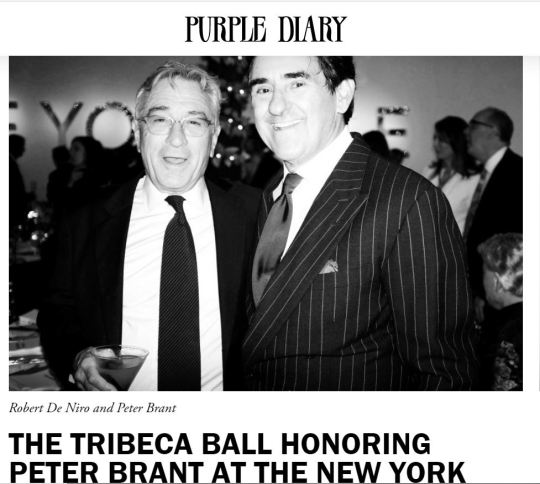

Finally, in studying the family history, I find the DeNiro crime family in Illinois, Ohio. Remember above, his mother lived there before moving to Berkeley, California and much of her family history is in Illinois. The Wikipedia says she was born in Oregan, lived in Illinois, then moved to Berkeley. The connection of his mother to Illinoise where the DeNiro crime family lived cannot be ignored.
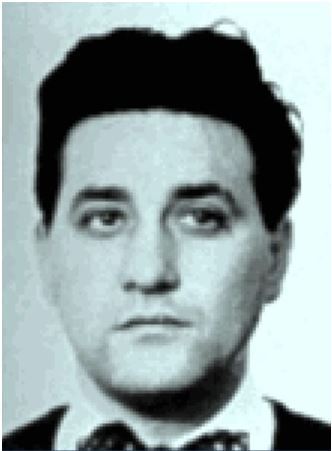
James V. “Vince” DeNiro was a notorious Youngstown, Ohio mob associate and gambling boss. He was born 1922 and died in 1961 from a car bombing. DeNiro was considered handsome and debonair and known as one of Youngstown’s “policy Kings”. He ran the Dry Men's Social club and owned the Cicero restaurant. “DeNiro became one of the leading underworld figures in the Mahoning Valley during the 1950s and early 1960s and was heavily involved in the numbers racket.” His rival was of the Naples family, Joseph "Sandy" Naples both vying to be the “top mobster in Youngstown beginning in the early 1950s.”
He had close ties to the Cleveland crime family: Calogera Malfitano considered to be his mentor; "Cadillac Charlie" Charles Cavallaro, and "Tony Dope" Anthony Delsanter. His rival, Sandy Naples and his girlfriend was gunned down in 1960 and it was believed he was behind it. Naple’s brother, Billy Naples, was killed the following year in a car bombing. He surrendered to police but was not charged due to lack of evidence. Not sure, but he looks an awful lot like Robert “Bobby Milk” DeNiro: https://mafia.wikia.org/wiki/Vince_DeNiro
youtube
It is interesting to note, Vince’s great nephew is Vincent L. DeNiro and he is involved with special effects and stunts for movies. He has an interesting history but most notably he speaks Ukranian and does “Theatrical Armorer for Hollywood, Expert Witness - Firearms (accidents, movie industry, faulty design issues, etc.), commercial sales, military and LE contracts, and distribution. Have I “done it all” in the firearms industry? Well, just about everything!” He was also a deputy sheriff in Youngstown, OH as well he notes that he “ led the defeat of the first city “assault weapon” ban in the U.S. in 1989, which made national headlines.” https://www.linkedin.com/in/vincent-l-deniro-501311b

His brother, Louis DeNiro, was noted in his obituary to have been a member of St. Anne Ukrainian Catholic Church in Austintown:
https://www.findagrave.com/memorial/148374810/louis-r-deniro
The Ukraine connection is because he is married to Katherine Danylyk which is a Ukrainian last name and her uncle died in Texas: https://www.legacy.com/obituaries/houstonchronicle/obituary.aspx?n=michael-danylyk&pid=159897791&fhid=10889
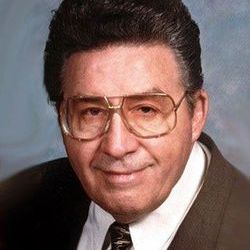
His brother is William DeNiro, also deceased and is noted to have a grandson named “Robert”, maybe just a coincedence, but there is a striking resemblance of DeNiro, his dad, and his uncle to this family in Illinois:
https://www.findagrave.com/memorial/146664719/william-paul-deniro

Continued digging needed to see if a connection can be made! Stand by for updates.
Thanks,
BelleauSkye Anon
2 notes
·
View notes
Text
A castle a day...
Well, I guess it would keep some people away, but certainly not me, haha.
That’s right, I visited another castle today! This time a little closer to Okayama, so no 3 hour train ride – just a little under half an hour. That’s just the first step in visiting this castle, though.
Follow me under the link for today’s report on Bitchu Takahashi!
Apparently there are more cities named Takahashi, so to make the distinction, the station in the Okayama prefecture is called Bitchu Takahashi for the western region of Okayama. For eh, most likely understandable reasons, I’ve also seen it written in Latin script at Bicchu. Anyway! There are several trains bound for this station, but the fastest from Okayama is the Yakumo line, which means ‘thick clouds’. Thankfully it didn’t live up to that name today, as the skies were very clear for the most part. The Yakumo only stops at Kurashiki, so it’s a quick trip. Of course, I was once again way too early at the station, so I killed some time by reserving a seat for myself. Not sure if it was necessary, but at least I could sit for sure!
Once at the station, I had my first surprise of the day. The tourist information center isn’t stuffed right next to a convenience store like at Matsuyama yesterday, but instead holds office at the city library above the station, which has four floors and also houses a book store and a Starbucks. I could actually just spend half a day here, haha, but that wasn’t why I was here. I needed a way to the castle, as that was still over an hour and half away by foot. Luckily there is a solution: a shared taxi. Of course, the normal taxi is also an option, but then you need to call one for the way back, and it’s also more expensive. You can call ahead for making reservations or just show up, which I did. Luckily, the next taxi still had place for me. They offer a discount ticket with entrance to the castle, two samurai houses and a temple, so I got one of those and then lingered around to wait for the taxi.
I got talking to several Japanese ladies and a couple from Australia, so I got to practice my languages today, haha. I could uphold conversations! Whoo! It probably helps they were castle related, and as it turns out I have very specific vocabulary now, ahem.
Anyway, I haven’t even told you why it was so necessary to take a taxi. You see, this castle is on top of a mountain at 430 meters above sea level, making it the highest original castle tower in Japan. Because yes, it is one of the only twelve castles of which the main tower is still standing from the feudal age onward. Matsuyama castle yesterday was another one, and to make matters more confusing, this castle today is also called Matsuyama castle. Yay for more double names! Like with Takahashi, it’s often called Bitchu Matsuyama castle to avoid such confusion.
With those facts in mind, you might understand why I was so excited about visiting it, despite the troubles of getting you there. The taxi got us almost all the way up, but from the parking lot, it was still a 20 minute uphill walk through forests. The weather was lovely and the trees shielded me from the sunlight, so that was actually pretty okay, haha. I don’t think walking all the way from the station to here would have worked out for me, so I’m glad for the taxi, but overall, I can’t really complain about the way here. It’s definitely not an accessible castle, though.
Upon arriving, I was immediately treated to some very impressively imposing walls. That is definitely a fortress right there! It might be the oldest surviving castle (although I’ve heard the same thing said about Inuyama castle), and the first construction was already in 1240 on a nearby mountain. That being said, the domain switched hands and the current structure is from a later era, probably the 16th century, a time when castles also became status symbols. Bitchu Matsuyama castle however was primarily constructed as a defensive fortress, very out of reach on top of the mountain and only needing 2 stories, as the height of it meant that they already had a great look-out point.
The views are indeed rather spectacular, especially in this weather with the first leaves turning bright red. But it’s understandable the castle was never really under siege and the Meiji government didn’t bother tearing it down, since without the taxi, it really is a tough one to reach.
Anyway! I made it to the main tower, which is indeed small, but looks amazing on that mountain top. I handed in my ticket and made it into the premises, to be immediately confronted with a very important character: Sanjuro, who was installed as honorary lord of the castle last December. Also, Sanjuro is a cat, haha. (Japan has multiple cats with jobs; just look up Tama, the station cat.) Last year’s summer was heavy on this region and brought floods, so the cat ran away from home and ended up here. He got adopted first as mascot, and was eventually dubbed as lord. And Sanjuro is personally responsible for the return of tourism here, as that had dropped significantly due to the floods in the region. He now lives here and makes rounds twice a day.
Afte that cute intermezzo, I went into the main tower and explored it. They did bother putting up information and displays here, although everything was in Japanese, and since it’s only two rather small floors, you can go through this pretty quickly. I was actually glad for that, because the taxi would come to pick us up only an hour and a half after dropping us off, and we still had to walk back to the parking lot.
Once outside, I walked around the castle and found a spot where I could see the turret from a better angle. The turret, along with a part of the wall and the main tower, are the only buildings left standing, so the premises aren’t big, but combined with the view and the beautiful nature, it makes for a wonderful outing. The whole package makes this castle score very high in my personal favourites, and trust me, I’ve seen quite some castles by now to make a good comparison, haha. I walked behind the castle a bit further to find some remains of I assume walls and a well, although it was mostly overgrown here, but the views and forest remain splendid, plus I saw a really pretty butterfly! Well, the castle does sit on Mount Gagyu, a designated national forest, so there’s that.
I then started making my way back to the parking lot, where I found the rest of the group I had travelled up with. The taxi dropped us off at the foot of the mountain rather than at the station, but for good reason: we were at the entrance of the Orii samurai residence, for which we had a discount ticket. The residence was actually pretty big, and it featured pretty lifesize dolls to bring some extra character into the house. It has a pretty garden, too. Right down the street, there is another samurai residence, the Haibara family one, who were high ranked samurai.
After these two quick but nice visits, the walk continued to the final discount ticket place: Raikyuji temple. In the early 1600s, lord Ensyu Kobori took up residence in this temple instead of at the castle to be safe from war. He was involved in the development of the tea ceremony and designed gardens, so in this temple, you can find a very pretty rock garden, which is meant to be enjoyed and not walked in.
It really is lovely, although I found myself charmed by something else: there were small Buddha statues spread over the premises featuring the animals of the zodiac, so I had fun spotting them all. Well, all – I miss one, and when I went ‘what was that one even? A snake?’ I uh, ran into an actual snake, so I called it quits before I could accidentally summon other animals, haha.
It was pretty easy to walk back to the station from here, as I just had to follow the train tracks. Along the way, I came across some more temples and shrines, and generally just walked through a very charming town.
Just before the station, I could spot the castle way in the distance, so I whipped out my fancy zoom lens to take a picture of the main keep from here, haha. It really is high…
At the station, I ordered some Halloween specials at Starbucks since I’d only quickly had one bread roll in between all my exploring and settled in for a bit before returning to Okayama. I was lucky and caught another Yakumo, so that was a quick ride back.
And now I’m back in the hotel! I have been for a while, but I had to go back out for dinner and all, haha.
I’m trying to think of what to do tomorrow, as they predict rain for pretty much the entire country on Friday, and my Saturday is already fully booked. As I leave for Tokyo on Sunday morning, tomorrow is my only day with nice weather left, so hm.
I might go on a walk, but I’m not sure if I’m awake enough for that, haha. Regardless, the day trips I still have written out as options are less than an hour from here, so I won’t have to get up super early, yay!
Good night for now and see you tomorrow!
3 notes
·
View notes
Text
TV Is Unwhitewashing History One Character, Period, and Genre at a Time
From “Les Miserables” and “Harlots” to “The Spanish Princess” and “The Terror,” TV producers are restoring the historical narratives of people of color.
Black characters on a show set in Tudor England would be a “stark anachronism” one consultant told “The Spanish Princess” co-showrunner Emma Frost in no uncertain terms. “Even I knew just from basic research that that wasn’t true,” she said in an interview with IndieWire during a set visit last year.
As TV shows seek out more inclusive storytelling, many producers are looking to the past to find new ways to freshen old stories. And while historical records and artwork have shown plenty of black, brown, and Asian faces through centuries of Western history, that same diversity has been largely absent in history class and on the screen unless it takes place after the 1950s. This dearth has affected the types of roles offered and even considered by actors of color.
Mandip Gill, who plays a British police officer of South Asian descent on “Doctor Who,” has only performed in contemporary projects. “I have always said I won’t be in a period drama. I just don’t see it happening,” she said. “I can’t even imagine it. When I’ve written down what types I like to play or where I would like to push the boundaries, it’s not with period dramas. I don’t watch them because I can’t relate to them.”
Danny Sapiani has had a better track record for landing period roles — such as Will North in “Harlots” and Sambene in “Penny Dreadful” — but that wasn’t always the case. “Period drama on screen was not a consideration when I began my professional career. Most film and tv roles were confined to the modern era, post-1950s, ghetto-ized in nature or victims of oppression,” he said.
David Oyelowo, who stars as Inspector Javert in the upcoming PBS-BBC adaptation of “Les Miserables,” agrees. “That was the case for me. And having grown up in the UK, and more specifically, on period drama, I had just resigned myself to the fact that, ‘Okay, those amazing shows are going to be shows I love, but they’re never going to have folks like me in it.’”
Sites like The Public Medievalist and historians like Onyeka have worked to challenge the narrative of the pure-white Western history that’s been widely accepted, even by people of color. Now actors and producers are following their example to restore the place of marginalized people on screen and into the public consciousness.
“The excuse has been used that it’s not historically accurate, and that’s just not true,” said Oyelowo. “If you are an actual genuine student of history — and not just coming from an ignorant kind of purely white lens in relation to European history — you’d know that people of color have been in France, in the UK, all over Europe, for centuries, and not just as slaves.”
Sapiani points to the discoveries and documentation available for anyone to research about the existence of people of color in Europe for centuries.
“As evidenced by the discovery of Cheddar Man, the first complete skeleton found in a gorge in Somerset, the first modern Britons who arrived on the island 10,000 years ago had black to brown skin, blue eyes and dark wavy hair. It is from these earliest arrivals that the inhabitants of Britain derive their origins,” he said.
“In fact, there are very few periods in history where people of color do not feature, not only in Britain — the setting of most costume dramas — but across the entire European continent. The census notes 20,000 blacks living in Britain in 1780, the century we focus on in ‘Harlots,’ more than half that number living in London, which is where ‘Harlots’ is set. Even though this was during the height of the slave trade, not all those people were slaves or victims of white racism. Fascinating characters like Will North, spanned social and class boundaries, often, though not always, against incredible odds.”
Hulu’s “Harlots,” about the war between two brothels in Georgian London, not only features the free man Will North, but also several black harlots, one of whom ran her own brothel.
“There were tens of thousands of people of color living in London in the 1760s. We have found stories of musicians, estate managers, fencing masters, actresses, grocers, prize fighters, haberdashers, soldiers, poets, activists, librarians and clerks,” said “Harlots” co-creator Moira Buffini.
“Some were clearly people of means, like the ‘black lady covered in finery,’ spotted by Hester Thrale at the opera. ‘Harris’s List of Covent Garden Ladies’ has entries for several women of color who were making their living in the sex trade and The Nocturnal Revels tells us of ‘Black Harriot,’ a very successful courtesan who ran a popular ‘house of exotics.’ All our stories are about people trying to find agency when society gives them none — and this seems in especially sharp relief for our characters of color. Violet is a street whore and pickpocket but from her perspective, society is the thief. Her mother was stolen. Violet, in her own eyes, is neither victim nor criminal. She has a raw integrity and a personal truth that others find both intimidating and irresistible.”
For “The Spanish Princess,” an adaptation of two Philippa Gregory historical novels set in Tudor England about Catherine of Aragon, Frost and co-showrunner Matthew Graham turned to books by Onyeka to develop characters of color who would have fit in during that time. In particular, they discovered the story of the real-life Lina de Cardonnes (played by Stephanie Levi-John in the series), a high-ranking noble woman who acted as Catherine’s lady-in-waiting and companion.
“There was a character that was referenced in Phillipa’s books who was what they call a dueñas or a lady-in-waiting to Catherine. Her name was Catalina de Cardonnes and she was just this larger than life character who was depicted as white Spanish,” said Graham. “Then we just did a bit of cursory research and discovered that it was based on Lina de Cardonnes and that she was African Iberian. She was a black lady. So, we were certainly like, ‘Wow, this is a bigger story and a more interesting story than we can possibly imagine.’”
This discovery of the larger part that people of color have played throughout history has been increasing the more people look into telling marginalized stories. The author of “The Miniaturist” Jessie Burton and Netflix’s “Anne With an E” creator Moira Walley-Beckett had similar epiphanies and added black characters in significant roles to their stories set in the Dutch Golden Age and Edwardian Canada, respectively.
In many of these cases, ignorance or acceptance of the dominant narrative could explain the lack of representation in these TV shows. The absence of photographic or film evidence made it easier to whitewash the presence of people of color.
But there’s really no excuse with period dramas set in the 20th century and beyond, when plenty of visual records show the diversity present. As with the #OscarsSoWhite campaign started by activist April Reign, the biggest problems facing more inclusive TV lay in challenging the mindset at the studio level and changing who’s behind the camera.
As seen with many of the shows that are including people of color in historical narratives, the show’s creators are often women, people of color themselves, or part of the LGBTQ community. When marginalized groups help each other, this can address intersectionality.
For example, Carol Hay and Michelle Ricci co-created the Jazz Age mystery adventure show “Frankie Drake Mysteries” coming to Ovation on June 15. Not only did they make a show about Toronto’s first female private detective, but they also cast Chantel Riley as Trudy, Frankie’s partner who happens to also be a black woman.
“When Shaftesbury [Films] came up with this idea and decided to have a black female lead, it was mind-blowing to me because you never really hear about black folk or Asian folk, in that time,” Riley said. “We touch on the Asian community, the black community, even the Indian community as well. That’s why I was really attracted to this particular show, because no one’s really doing that in this particular era.”
In some cases, actors have had to step behind the cameras themselves to increase the opportunities for people of color. Daniel Dae Kim left “Hawaii Five-0,” and the first series that he produced afterward is ABC’s “The Good Doctor,” which has provided numerous on-screen opportunities for actors from marginalized groups.
Similarly, Oyelowo became an executive producer on “Les Miserables” to take control of how his role of Javert and the other people of color were portrayed. Oyelowo also co-produced and starred in the period film “A United Kingdom.”
“I wanted to make sure that me being in [‘Les Miserables’] wasn’t going to be a token thing. I wanted to make sure that people of color were integrated through the story in an organic way that didn’t feel imposed,” he said.
“But also, something very important to me was the American distribution. I wanted it to be on a channel that was worthy of the work that everyone was putting into it. And so, I had a hand in it going to PBS Masterpiece. Anything that takes me away from my kids for any period of time better be worth it. And so, some of the times I produce in order to develop. Some of the times I produce in order to be able to have a say in how things are cast, how they are marketed, how they are distributed. And that’s basically been the case with this.”
Currently, there aren’t many period shows by people of color about people of color on TV. John Singleton’s “Snowfall” on FX is set in Los Angeles during the 1980s crack epidemic and was renewed for a third season.
Over on broadcast, the late 1990s-set comedy “Fresh Off the Boat,” based on the memoir of Eddie Huang and created by Nahnatchka Khan, a queer woman of Iranian descent, is currently in its fifth season. It’s the first TV show with an Asian cast in over 20 years — since Margaret Cho’s short-lived “All American Girl” — and stars Randall Park and Constance Wu as the Huangs, who had relocated to the Florida suburbs with their family. Khan had to make a case for why the show had to remain in the ‘90s to replicate the real-life Huangs’ feelings of alienation.
“I remember having a creative discussion with 20th [Century Fox] at the very beginning about them asking me, ‘Why does it have to be set in the ‘90s?’” she said. “For me it was creating a sense of isolation with the family. They moved to Orlando in the middle of the white suburbs and they don’t know anybody. But in the present day, you can get online and talk to your friends and you can text people. You have a connection outside of your everyday life, even if it’s virtual.”
Other than those, “Underground” was the last period show about people of color by a creator of color, Misha Green. WGN’s critically acclaimed slavery-era period drama lasted two seasons and was canceled shortly after Sinclair Media Group announced it would purchase Tribune Media, which owns WGN.
Fortunately, this scarcity won’t last for long. Many period shows that feature significant narratives for people of color are on the horizon. Green has teamed up with Jordan Peele for the HBO drama horror “Lovecraft Country,” which takes place on a road trip during 1950s Jim Crow America. Barry Jenkins executive produces and directs the upcoming Amazon series “The Underground Railroad,” an adaptation of Colson Whitehead’s book. Justin Lin and Jonathan Tropper’s “Warrior” premieres April 5 on Cinemax and is based on Bruce Lee’s original concept about a Chinese immigrant who becomes a hatchet man for the most powerful tong in late 1800s Chinatown in San Francisco.
One other upcoming series explores a new genre for the period TV show that adds a provocative take on a historical event. In its second season, AMC’s anthology series “The Terror” explores the internment of Japanese Americans during World War II through the lens of Japanese horror. Actor George Takei, who experienced internment, acts as a consultant and series regular.
“We’re telling the story of a very underserved piece of American history using the vocabulary of Japanese-style horror as an analog for the terror of the actual historical event,” said co-creator and showrunner Alexander Woo.
“I don’t want the audience to feel removed from the events that are happening on screen. What a horror movie or horror series does is it makes you feel viscerally in the shoes of the person who’s trapped in the house or the person who’s running away from the monster or whatever it is. So we’re using that style, that language, to make you really feel how terrifying the experience of the Japanese Americans who lived through this terrible experience.”
While the Japanese ghost story trappings fits the tone of the narrative in “The Terror: Infamy,” Woo acknowledges that the genre twist might have helped pitching the show.
“We’re in an era of so much content and a period of such creative power, we have more sophisticated viewers that will hopefully appreciate a period drama told in a specific style,” he said. “Those two things used to not mix. That was not something that you would want to try because it might seem complicated or it might seem challenging, which I think now, in this time, that sounds very appealing… It’s also a terrific lens for us to understand things that are happening in the present. The story of internment is obviously relevant in a host of ways to the present day, so I think it’s a valuable story and has to be told now.”
While these more inclusive narratives continue to be discovered and told, inevitably people used to the status quo will resist and deny those stories. It’s the very reason that these stories haven’t been told in the first place.
“The more recent phenomenon of whitewashing, a political tool of the imperialists, dates back only a few hundred years,” said Sapiani. “I am so proud to see, and be a part of this change towards a more accurate and frankly more interesting dramatized interpretation of our world history. Needless to say, there is so much further to go.”
https://www.indiewire.com/2019/03/tv-unwhitewashing-history-period-dramas-hbo-hulu-pbs-abc-1202049639/
5 notes
·
View notes